|
Postcards
from:
Las Vegas Nevada
Algeciras Spain
Rabat Morocco
Madrid Spain
Yaounde Cameroon
Douala Cameroon
Addis
Ababa Ethiopia
Lalibela Ethiopia
Axum Ethiopia
Gondar Ethiopia
Bangkok Thailand
Las Vegas Nevada
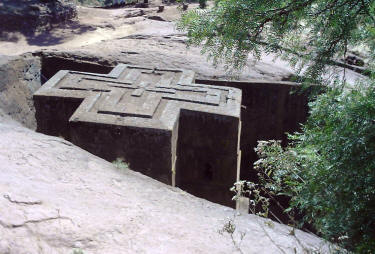
Lalibela Ethiopia: Bete Giyorgis or Church of St. George is the iconic view
for the region and best known of the eleven rock-hewn churches.

Lalibela Ethiopia: Details of sculptured windows in the wall of one of the
eleven rock-hewn churches located in this region.
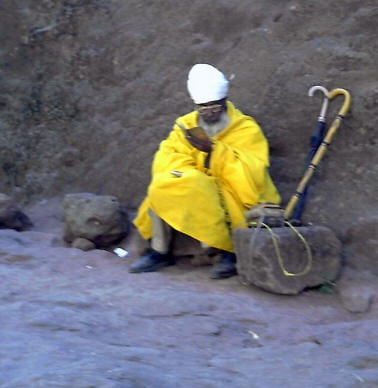
Lalibela Ethiopia: This yellow clad priest sat
reading his "New Testament" Bible in Amharic. With
gestures I indicated my interest in his activities
and he responded by showing my his book... followed
quickly by opening his yellow robe to show me a tear
in his coat and gestures easily understood as a
request for money... breaking the spell of an
otherwise "holy" encounter.
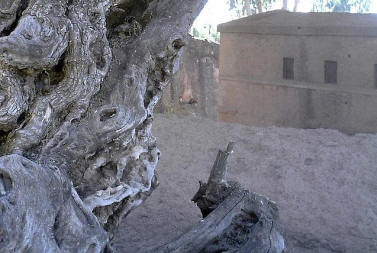
Lalibela Ethiopia: This is the first of the eleven
rock-hewn churches located in this region I found in
my explorations of the area..
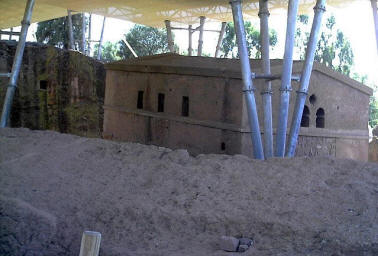
Lalibela Ethiopia: First view of the first of the
eleven rock-hewn churches located in this region.
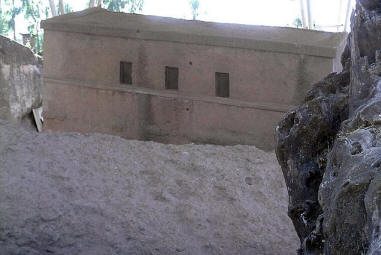
Lalibela Ethiopia: Another view of the first church
I found of the eleven rock-hewn churches located in
this region.

Lalibela Ethiopia: Details of sculptured pillars
along the wall of one of the eleven rock-hewn
churches located in this region. Notice the metal
support poles holding the protective covers over
most of the archeological excavations.
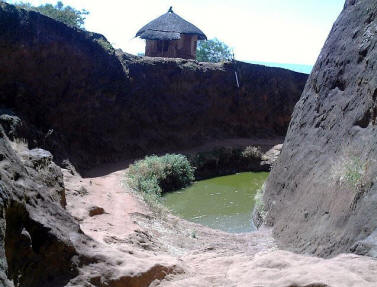
Lalibela Ethiopia: At certain times of the year
water floods some of the numerous tunnels and
trenches which connect many of the eleven rock-hewn
churches located in this region.
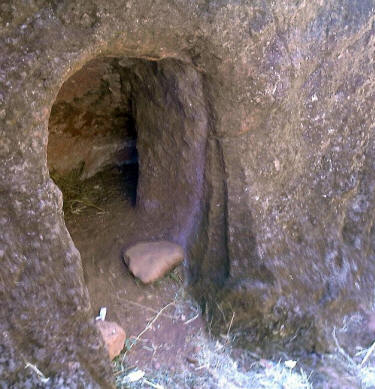
Lalibela Ethiopia: Small tombs like this one pock
the walls of trenches and tunnels around one of the
eleven rock-hewn churches located in this region.

Lalibela Ethiopia: That narrow slit is at least
twenty feet high and is the entrance to a dark
tunnel going to one of the eleven rock-hewn churches
located in this region.

Lalibela Ethiopia: Here is a closer view of that
narrow slit which is at least twenty feet high and
is the entrance to a dark tunnel going to one of the
eleven rock-hewn churches located in this region.
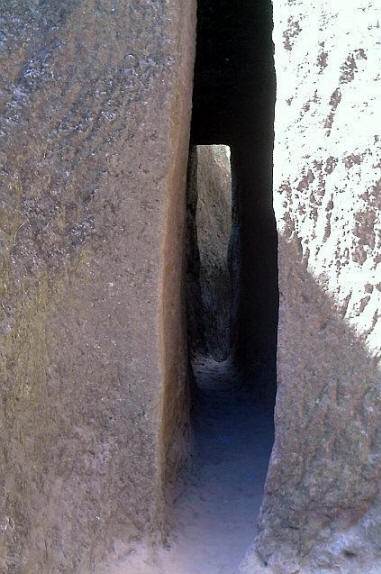
Lalibela Ethiopia: Looking through that narrow slit
which is at least twenty feet high and leads to yet
another tunnel going to one of the eleven rock-hewn
churches located in this region.
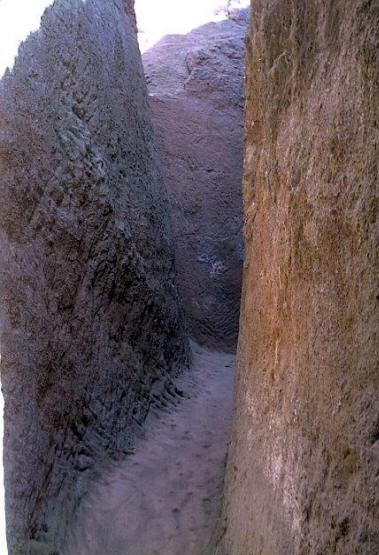
Lalibela Ethiopia: The deep trench continues on the
other side of that narrow slit going to one of the
eleven rock-hewn churches located in this region.
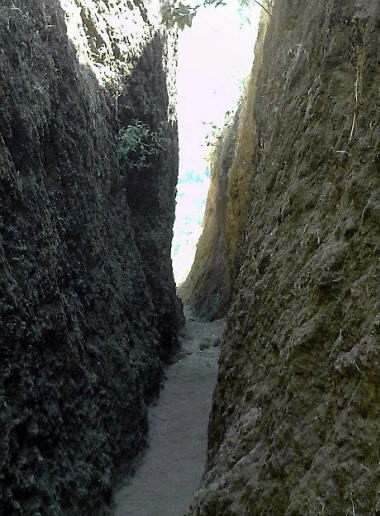
Lalibela Ethiopia: Another of the many deep trenches
connecting the eleven rock-hewn churches located in
this region.
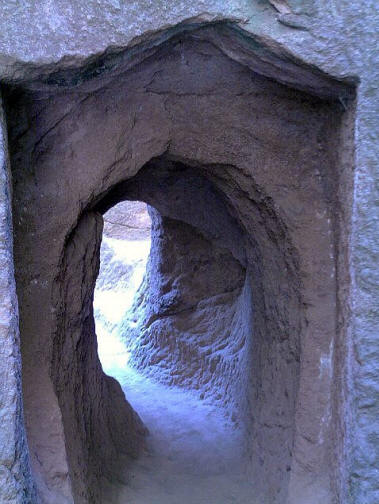
Lalibela Ethiopia: Another of the many tunnels
connecting the eleven rock-hewn churches located in
this region.

Lalibela Ethiopia: Details of sculptured windows in
the wall of one of the eleven rock-hewn churches
located in this region as seen from the entry tunnel
into the trench surrounding the sculptured church.
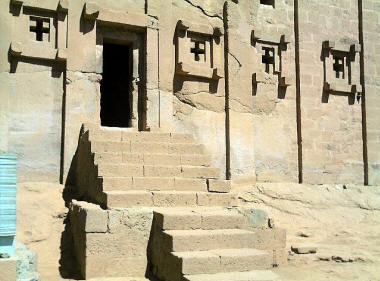
Lalibela Ethiopia: Details of sculptured windows in
the wall of one of the eleven rock-hewn churches
located in this region.
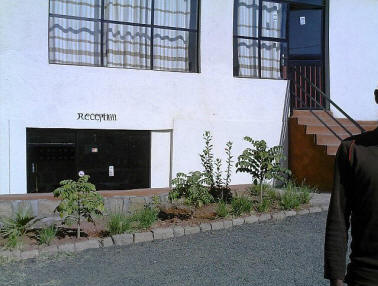
Lalibela Ethiopia: Entrance to the $45 Cliff View
Hotel which would have suited my needs except for
the fact they could not provide Internet access.
Fortunately, the Mountain View Hotel sat nearby and
a steep cobblestone pathway connected the two
properties. This hotel also became a way-point on
the path over to the Ben Abeba Restaurant I enjoyed
a couple times.

Lalibela Ethiopia: Flags representing the
nationalities of current guests at the $64 Mountain
View Hotel where I stayed three nights.
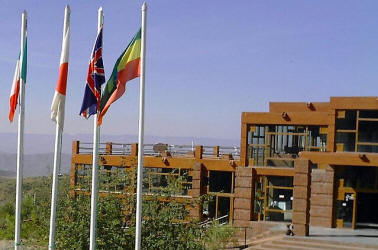
Lalibela Ethiopia: Entry view of the $64 Mountain
View Hotel where I stayed three nights. Internet
WiFi could only be used in the lobby and then only
occasionally as the server failed frequently.
Breakfast consisted of coffee, juice, brick hard,
stale toast with jam and an omelet when the staff
felt like providing it. Dining room service needs
drastic changes to meet Western standards.
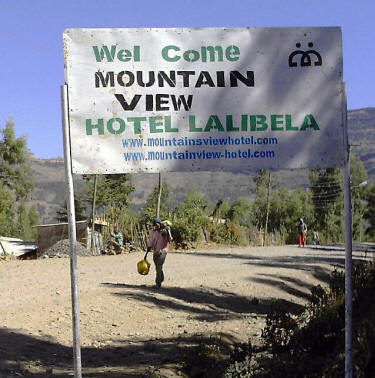
Lalibela Ethiopia: Sign does not sit at the entry road for the $64 Mountain
View Hotel where I stayed three nights. Following it got me to the very nice
$45 Cliff View Hotel not far from the Mountain View which had no Internet
connections. A foot path connected the two.

Lalibela Ethiopia: Artistic thistle patch on the dirt road connecting the
hotel and city center.
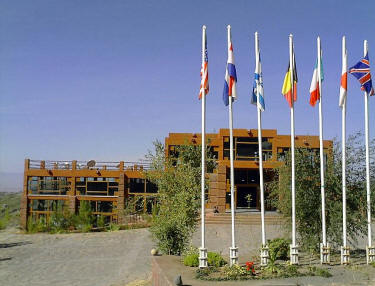
Lalibela Ethiopia: Entry view of the $64 Mountain View Hotel where I stayed
three nights. This is purported to be the best the area has to offer and the
architecture certainly deserves praise, but best stops there! The rooms are
just adequate and the dining room poorly managed, though the views of the valley are spectacular.

Lalibela Ethiopia: View of the $64 Mountain View Hotel where I stayed three
nights as seen from the dirt road connecting it with the center of the
village some two kilometers distant. There are no cabs here nor any ATMs.
Dollars or Euros can be changed at the lone bank in town and some hotels
will provide local currency on your credit card for a hefty 10% fee.
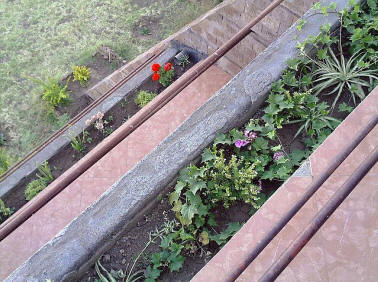
Lalibela Ethiopia: Planter box as seen from my room in the $64 Mountain View
Hotel where I stayed three nights. The spectacular view of the valley below
made up for other numerous deficiencies in the hotel.
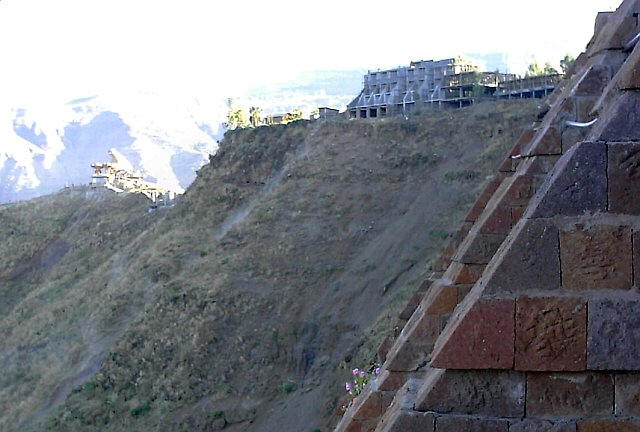
Lalibela Ethiopia: View of the extraordinary Ben Abeba Restaurant in the
distance on the far left of the ridge as seen from my room in the $64
Mountain View Hotel where I stayed three nights.
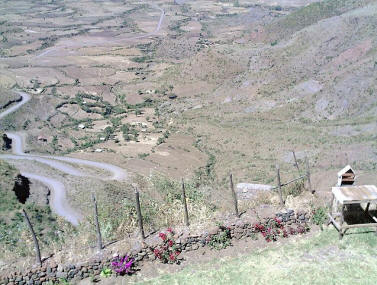
Lalibela Ethiopia: View of the valley below to the West as seen from my room
in the $64 Mountain View Hotel where I stayed three nights.
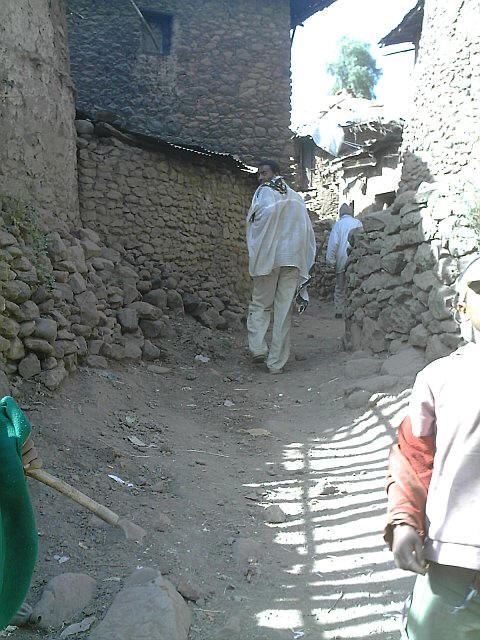
Lalibela Ethiopia: Little foot paths like this one weave their way through
the many village neighborhoods around the tourist areas. Visitors are
generally welcome to discretely explore. Some dwellings are simple modern
stone constructions like these; others are clusters of the round thatched
huts characteristic of more rural areas.
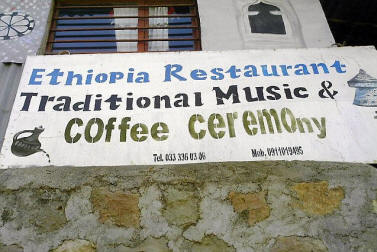
Lalibela Ethiopia: "Night clubs" like this one are scattered throughout the
areas frequented by tourists. Some are not much more than four crude posts
enclosed by corrugated iron sheets, but all promise to entertain one way or
another. Mention of the traditional coffee ceremony is common... and easily
performed with little fancy equipment.
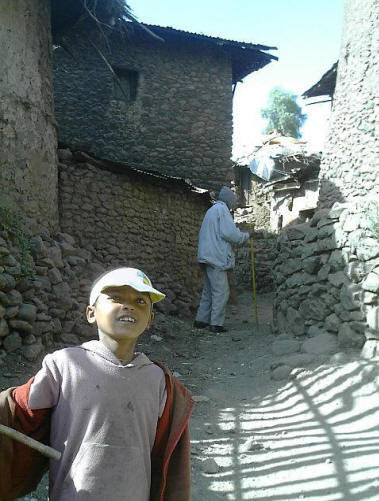
Lalibela Ethiopia: Here one of the swarm of boys takes notice of the white
foreigner and his little camera, yelling out "Hello, hello. Welcome!" like
an echo of the many other greetings before and after.
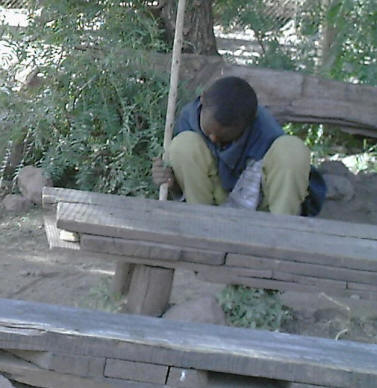
Lalibela Ethiopia: This young teenager worked on shaping a walking stick for
many minutes while I discretely followed his efforts with a sharp edged
stone as I imagined his ancestors must have done in ancient times past. He
deftly cut the end of the pole cleanly and scraped the surface smooth with
the stone tool. I felt privileged to witness this stone age performance here
in 2012.
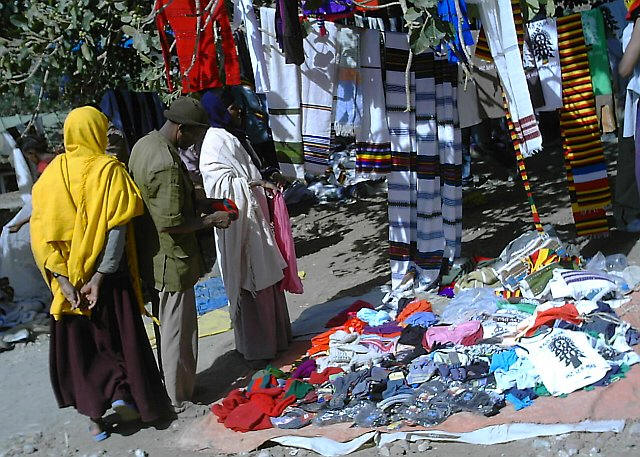
Lalibela Ethiopia: Local people as well as tourists shop for clothing.
Typical scene along the main paved road that runs along the area where all
the rock-hewn churches are located.

Lalibela Ethiopia: Religious artifacts and souvenirs along the main paved
road that runs along the area where all the rock-hewn churches are located.
Stylized wooden crosses of all sizes are a popular item for tourists.

Lalibela Ethiopia: Local people as well as tourists shop for clothing.
Typical scene along the main paved road that runs along the area where all
the rock-hewn churches are located.
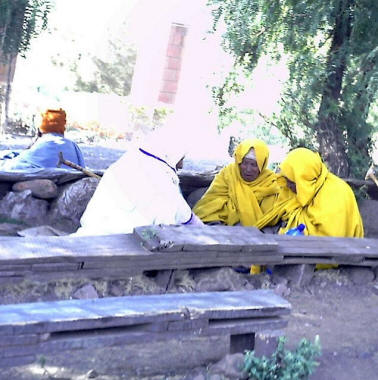
Lalibela Ethiopia: These ladies quietly enjoyed their lunch in the shade of
a resting area near one of the canopy covered stone churches. Using injera
as both food and an eating "utensil" they wrapped the thin sheets of the
spongy bread around a central pile of vegetables to bring it to their
mouths.
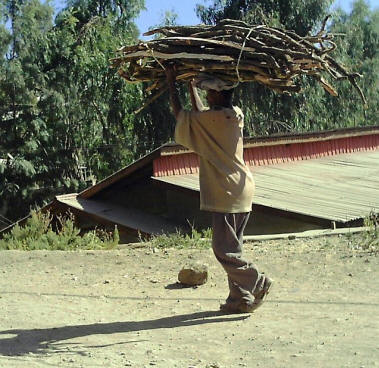
Lalibela Ethiopia: No one takes fuel for granted here. This guy is carrying
bundles of firewood, a scene repeated endlessly throughout my stay in the
area. People of all ages, both male and female participate in this essential
task.
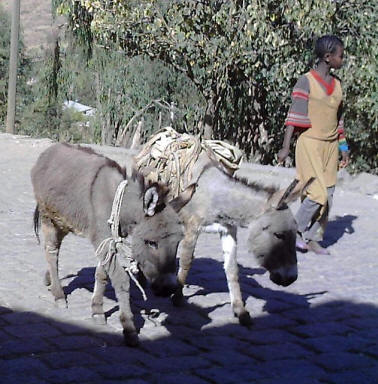
Lalibela Ethiopia: Their job done, this lady leads her donkeys home for
another load.
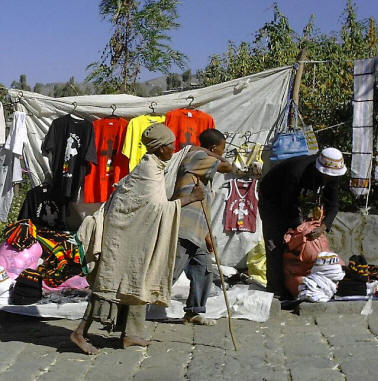
Lalibela Ethiopia: Local people as well as tourists shop for clothing.
Typical scene along the main paved road that runs along the area where all
the rock-hewn churches are located.

Lalibela Ethiopia: The city, small as it is draws
rural villagers to the resources of the "big city."
Villagers descend on Lalibela and its markets from
all directions. Some come here for medical treatment
in the area's only hospital. Anyone with a real
emergency and the necessary resources would quickly
fly out to more modern facilities in Addis Ababa.
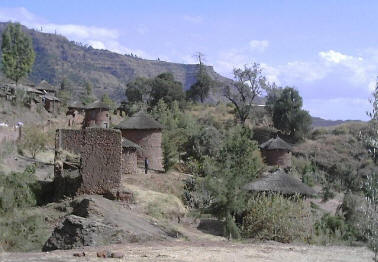
Lalibela Ethiopia: One of the typical villages
surrounding the main archeological area. I wandered
through such areas with impunity, generally without
any indication residents resented such intrusions.
Actually, quite a few people went out of their way
to greet me with friendly, though limited English
phrases like: "Hello... Welcome... Welcome to
Lalibela... Welcome to Thiopia..."... silent "E."

Lalibela Ethiopia: Locally produced clothing on
display along the main paved road next to the
archeological site entrance.
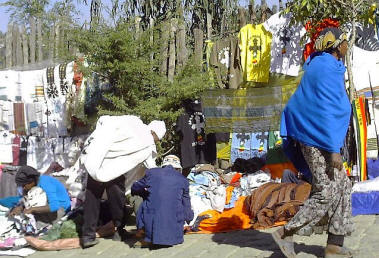
Lalibela Ethiopia: Local people as well as tourists
shop for clothing. Typical scene along the main
paved road that runs along the area where all the
rock-hewn churches are located.
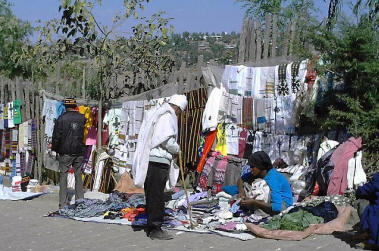
Lalibela Ethiopia: The street markets are popular
with local people as well as tourists.

Lalibela Ethiopia: Aerial photo of the Rift Valley
during our short flight from Addis Ababa to
Lalibela. The striated rifts are clearly visible for
most of the distance along the route.
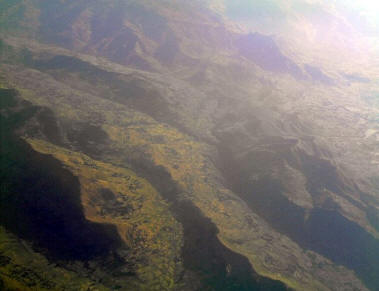
Lalibela Ethiopia: Another aerial photo of the Rift
Valley seen during the short flight out of Addis
Ababa.
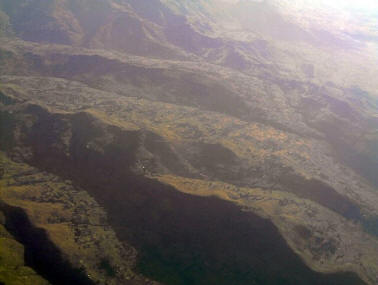
Lalibela Ethiopia: And still another view of the
Rift Valley during our short flight from Addis Ababa
to Lalibela.
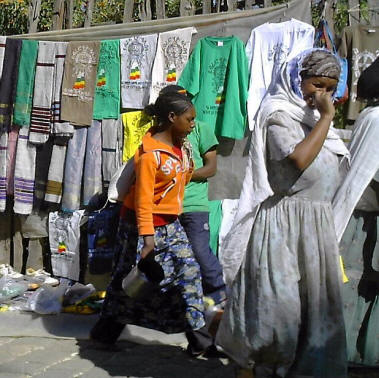
Lalibela Ethiopia: Most of the products on sale near
the archeological site are designed to appeal to the
foreign tourists.
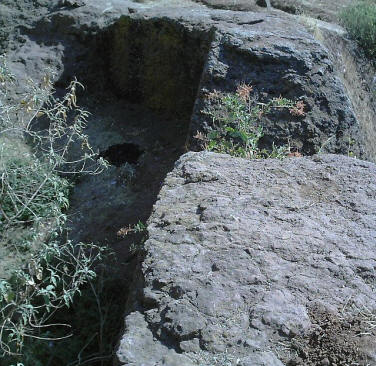
Lalibela Ethiopia: This is the first close up evidence of rock-hewn
construction discovered as I approached the main archeological area with
it's permanent protective canopies covering the excavations.
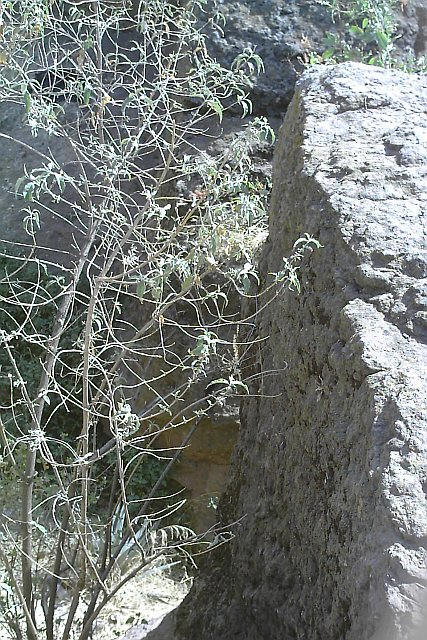
Lalibela Ethiopia: Another example of unfinished of rock-hewn construction
discovered as I approached the main archeological area with it's permanent
protective canopies covering the massive excavations.
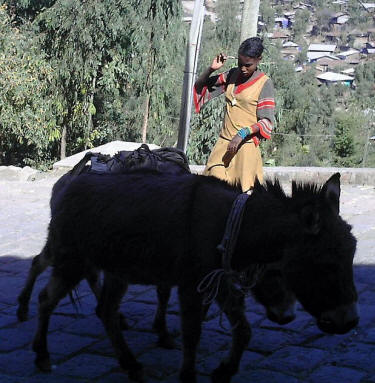
Lalibela Ethiopia: Their job done, this lady leads her donkeys home for
another load.
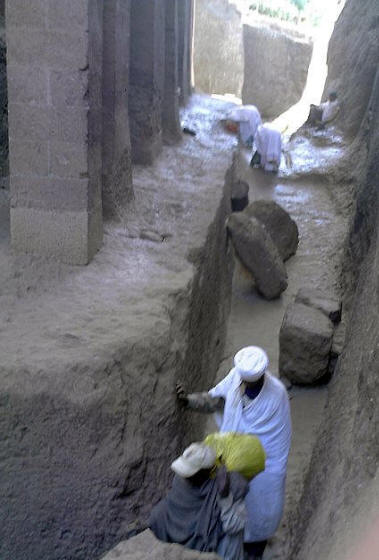
Lalibela Ethiopia: Visitors must follow trenches
like this one to locate the entrance to each church
of the eleven rock-hewn churches located in this
region.
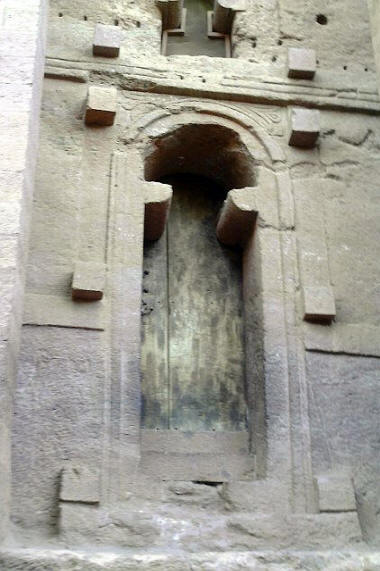
Lalibela Ethiopia: Details of sculptured windows in
the wall of one of the eleven rock-hewn churches
located in this region.
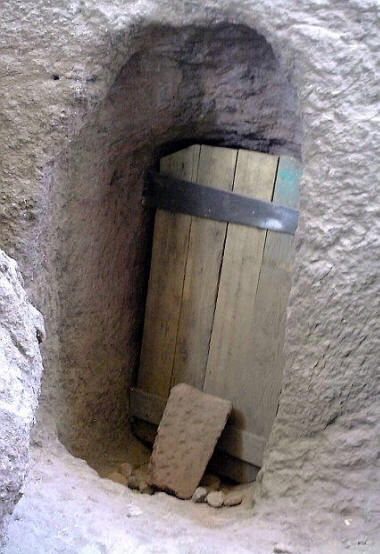
Lalibela Ethiopia: Details of wooden doors covering
the entrances in the wall of one of the eleven
rock-hewn churches located in this region.
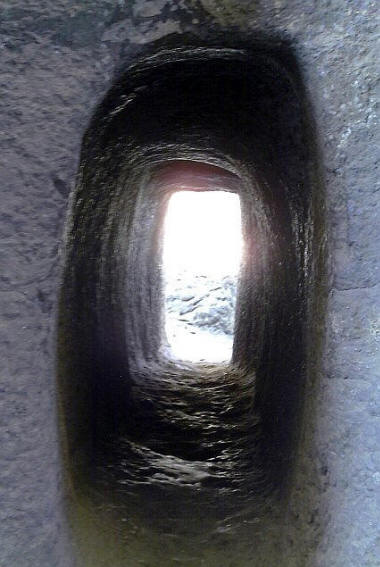
Lalibela Ethiopia: Tunnels like this one connect
pairs of churches of the eleven rock-hewn churches
located in this region.
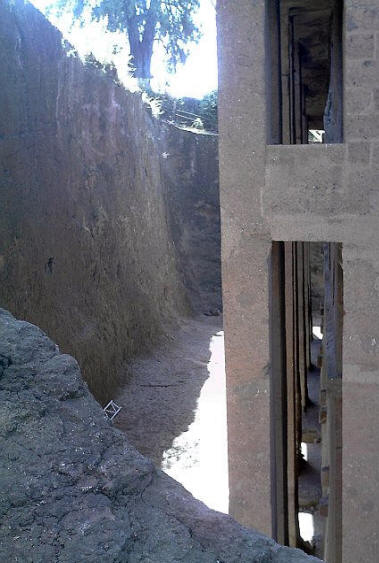
Lalibela Ethiopia: Details of sculptured pillars
along the wall of one of the eleven rock-hewn
churches located in this region.

Lalibela Ethiopia: Details of sculptured pillars
along the wall of one of the eleven rock-hewn
churches located in this region.
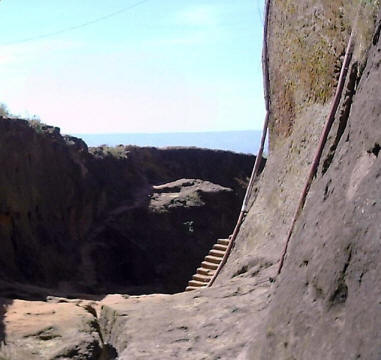
Lalibela Ethiopia: Tunnels and deep trenches connect
most of the churches to one another. The flight of
stairs carved into the stone here goes to one of the
eleven rock-sculptured churches located in this
region.
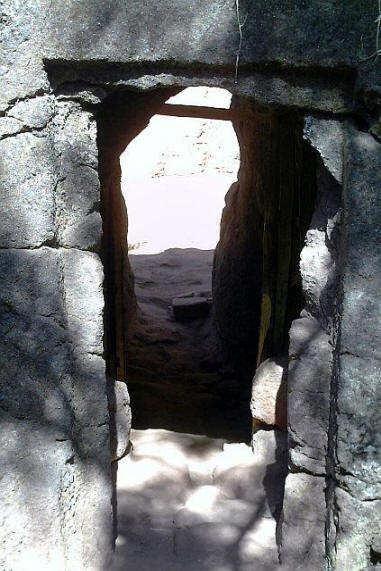
Lalibela Ethiopia: Another of the many entry tunnels
connecting the eleven rock-hewn churches located in
this region.
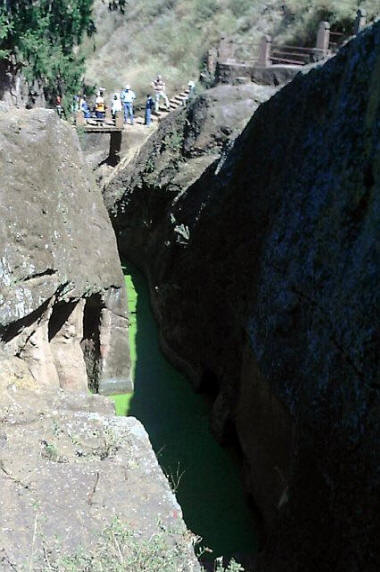
Lalibela Ethiopia: At certain times of the year
water floods some of the numerous tunnels and
trenches which connect many of the eleven rock-hewn
churches located in this region.
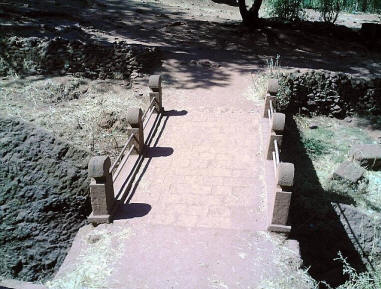
Lalibela Ethiopia: Bridges have been erected over
some of the numerous tunnels and trenches which
connect many of the eleven rock-hewn churches
located in this region.
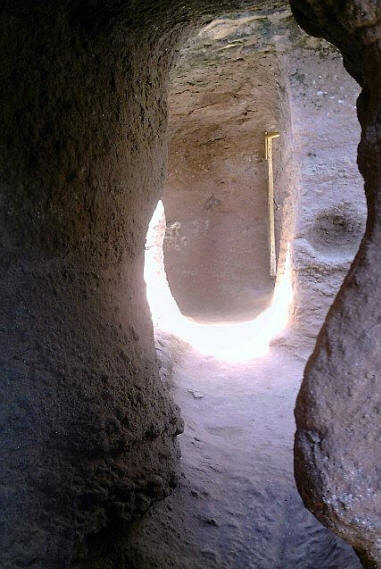
Lalibela Ethiopia: Numerous tunnels and trenches
connect many of the eleven rock-hewn churches
located in this region.
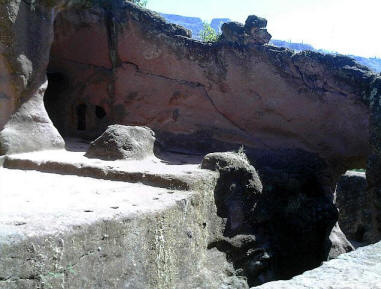
Lalibela Ethiopia: There is a lot of sculptured
stone not directly connected with any of the eleven
rock-hewn churches located in this region.
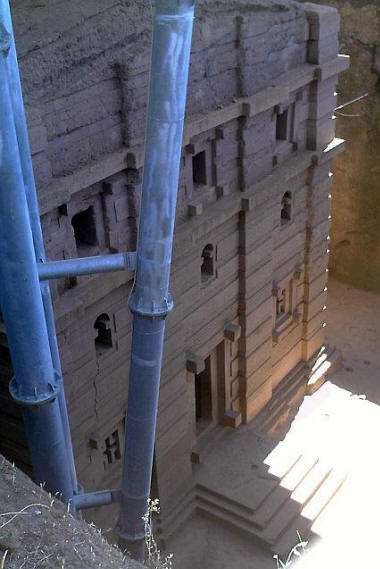
Lalibela Ethiopia: Details of sculptured pillars
along the wall of one of the eleven rock-hewn
churches located in this region. Notice the metal
support poles holding the protective covers over
most of the archeological excavations.
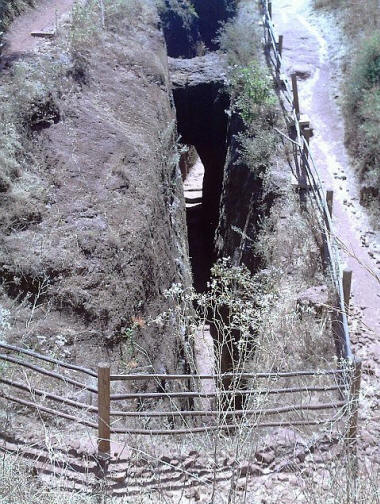
Lalibela Ethiopia: Looking down into the trench
surrounding one of the eleven rock-hewn churches
located in this region.
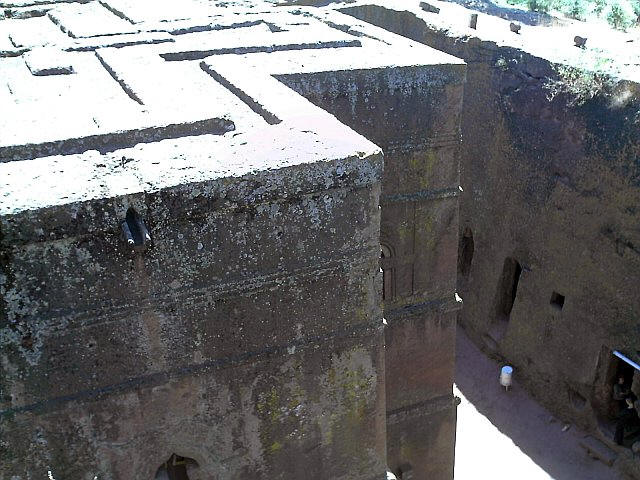
Lalibela Ethiopia: Looking down into the trench
surrounding the Biet Giyougis or Church of St.
George, the most famous of the eleven rock-hewn
churches located in this region.
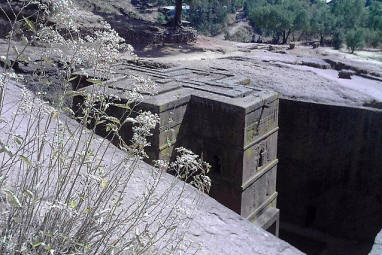
Lalibela Ethiopia: First view seen by visitors of
the Biet Giyougis or Church of St. George, the most
famous of the eleven rock-hewn churches located in
this region.
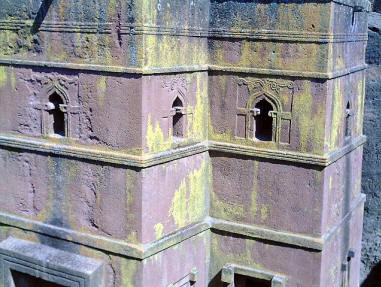
Lalibela Ethiopia: Closeup view of walls of the Biet
Giyougis or Church of St. George, the most famous of
the eleven rock-hewn churches located in this
region.
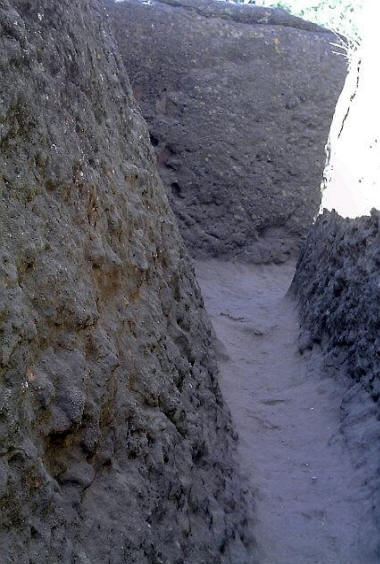
Lalibela Ethiopia: View of the trench leading to the
entrance of the Biet Giyougis or Church of St.
George, the most famous of the eleven rock-hewn
churches located in this region.
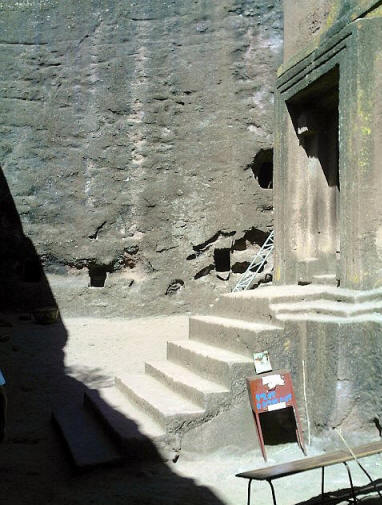
Lalibela Ethiopia: View of the entrance of the Biet
Giyougis or Church of St. George, the most famous of
the eleven rock-hewn churches located in this
region.
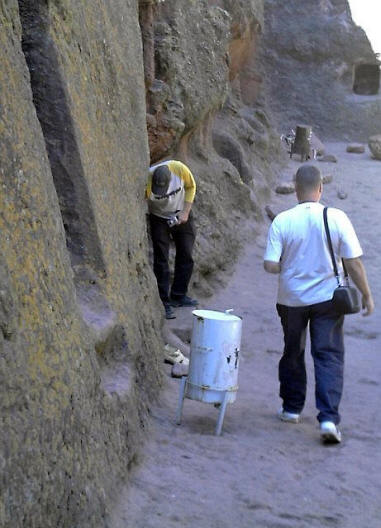
Lalibela Ethiopia: Two other impatient tourists
waiting for the reopening after lunch of the stone
structure near the entrance of the Biet Giyougis or
Church of St. George, the most famous of the eleven
rock-hewn churches located in this region.
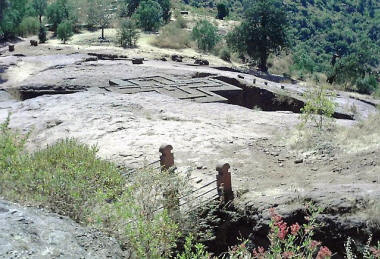
Lalibela Ethiopia: Another view
of the Biet Giyougis or Church of St. George, the
most famous of the eleven rock-hewn churches located
in this region. I took a lot of photos as I
circumambulated this iconic structure as I'll never
be here again.
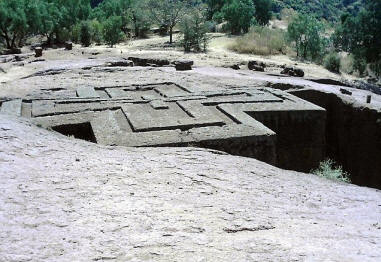
Lalibela Ethiopia: The roof of the church is level
with the surrounding ground here at the Biet
Giyougis or Church of St. George, the most famous of
the eleven rock-hewn churches located in this
region.

Lalibela Ethiopia: From another angle we look at the
top of the Biet Giyougis or Church of St. George,
the most famous of the eleven rock-hewn churches
located in this region. I took a lot of photos as I
circumambulated this iconic structure as I'll never
be here again.
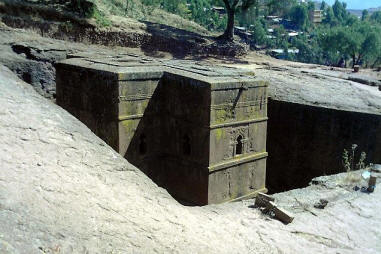
Lalibela Ethiopia: First view seen by visitors of
the Biet Giyougis or Church of St. George, the most
famous of the eleven rock-hewn churches located in
this region.
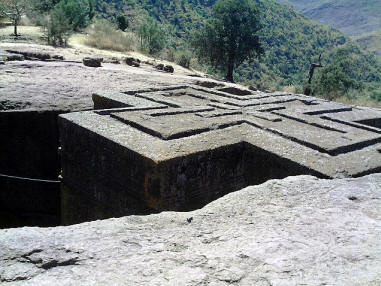
Lalibela Ethiopia: Another slightly different view
of the Biet Giyougis or Church of St. George, the
most famous of the eleven rock-hewn churches located
in this region. I took a lot of photos while I
circumambulated this iconic structure as I'll never
be here again.
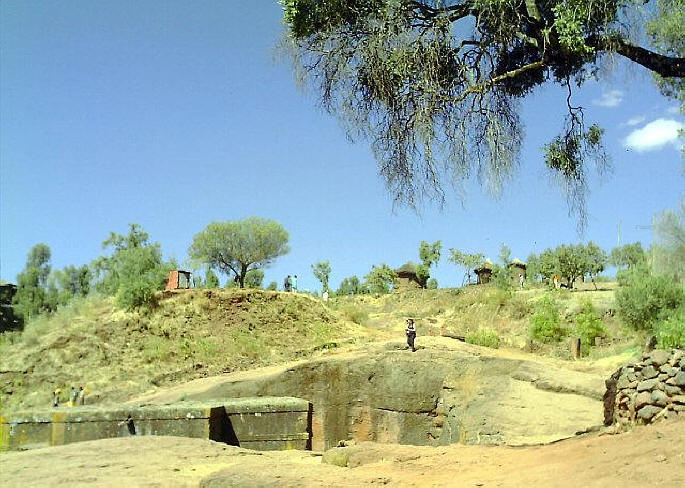
Lalibela Ethiopia: Looking back towards the entry
path leading to the Biet Giyougis or Church of St.
George, the most famous of the eleven rock-hewn
churches located in this region.
|
     10
January 2012 10
January 2012
Hello from
Lalibela Ethiopia,
Before I came to Ethiopia I'd
never heard of
Lalibela. A friend pointed out that none of
his maps make any reference to the place at all.
But, most of us have seen images of at least one
of the churches hacked from massive stone
outcroppings, the iconic cruciform structure
shown in the first picture to the left. Many
devout Christians of the Ethiopian Orthodox
Church consider this area particularly sacred,
making it a major pilgrimage destination several
times a year. Why the place is not more famous
internationally is no doubt due to its remote
location and lack of transportation
infrastructure. Foreign tourists are just
beginning to discover the unusual archeological
attractions and a number of new upscale hotels
are under construction in response to the
increasing demand.
For an informative introduction to amazing
Lalibela watch the full length History Channel
documentary
 or this short UNESCO
video or this short UNESCO
video
 . As you have no doubt noticed, I'm not
wild about repeating reams of encyclopedic
materials when a short hyperlink will do the job
better. I wandered around most of the eleven
churches during my three night stay in the area
and took a lot of pictures. Later I discovered
this video record . As you have no doubt noticed, I'm not
wild about repeating reams of encyclopedic
materials when a short hyperlink will do the job
better. I wandered around most of the eleven
churches during my three night stay in the area
and took a lot of pictures. Later I discovered
this video record
 made by another visitor; it is an accurate 30
minute recreation of what it was like to climb
around the ruins.
made by another visitor; it is an accurate 30
minute recreation of what it was like to climb
around the ruins.
Interestingly, I'll remember the
Lalibela area not so much for the Christian
churches
King Lalibela
 ordered built in obedience to
heavenly commands received during a poison
induced vision, but for the authentic Ethiopian
villages and rural
culture which have survived the onslaught of
Third Millennium civilization and the
extraordinary Ben Abeba Restaurant developed by
a charming expat Scottish woman. Mind you the
rock churches are phenomenal, but not unique in
the world. During a visit to
Madras in southern India during March 1986 I
saw similar monolithic stone structures. Ancient
Indian stone carvers created massive Hindu
temples some five or six centuries earlier than
those here in Ethiopia. The
Dravidian
Architecture of southern India not only
predate the excavations of Lalibela, but in many
ways is more elaborate and extensive than the
works found here. ordered built in obedience to
heavenly commands received during a poison
induced vision, but for the authentic Ethiopian
villages and rural
culture which have survived the onslaught of
Third Millennium civilization and the
extraordinary Ben Abeba Restaurant developed by
a charming expat Scottish woman. Mind you the
rock churches are phenomenal, but not unique in
the world. During a visit to
Madras in southern India during March 1986 I
saw similar monolithic stone structures. Ancient
Indian stone carvers created massive Hindu
temples some five or six centuries earlier than
those here in Ethiopia. The
Dravidian
Architecture of southern India not only
predate the excavations of Lalibela, but in many
ways is more elaborate and extensive than the
works found here.
Located in the
Amhara
ethnic division, Lalibela is home to many
traditional villages, some of which extend right
up to and into the archeological compounds. All
are well established and likely have been here
in their present form for eons. Today's
inhabitants carry on with their normal
activities and tolerate the foreign tourist
intrusions mostly with good humor, though on at
least one occasion an old woman scowled at me as
I lingered to study her walled enclosure and
photograph a flock of neighborhood children
practicing their few words of "greeting/begging"
English.
While Lalibela township with its
population of about 15000 is small by most
standards, it is the "big" city for rural people
living around it within a hundred kilometers. Country people
regularly walk great distances into the town to
shop and for other services not available in
their villages. I observed a group of twenty or
so nearly naked skinny young men in their late teens or
early twenties carrying a litter with an old
woman on it. One of the local people explained
they would be on their way to the
hospital and might have walked all day in
their bare feet to reach the town, explaining
why there were so many guys when only four were
needed to carry the litter at any one time. As I
paused to watch the urgent, but solemn
procession, I resisted the temptation to
photograph this rural Ethiopian ambulance
operation out of respect for the grim
faces filing by. While traditional healers
provide most of the treatment for illnesses in
Ethiopia, anyone who can afford it will first
seek treatment in a modern medical facility, if
possible. When that approach fails to produce
satisfactory results most patients will then
consult a
traditional healer. Traditional healers are
the first choice for the poorest as treatment is
never withheld for lack of financial resources.
Travel exposes one to an
extraordinarily broad spectrum of human
activities and attitudes. It also brings into
razor sharp focus the disparity between the
"haves" and the "have nots" of this world. For
the most part in much of Africa, the "rich"
remain in deluxe enclaves out of sight of the
poor... except where the poor have been employed
to keep the enclaves functioning in a manner
expected by the rich. One sees a lot of barbed
wire atop the tall walls surrounding upscale
homes throughout Africa. I'm still sorting out
the lessons learned and trying to fit them into
the context of my own life, hopefully in a way
that makes future writing more relevant.
People in this part of the world
are still very poor by Western standards, but
here in Lalibela I saw no evidence of hunger.
Large families do seem to be the norm, however.
During my bleeding heart liberal days, starting
as an undergraduate at UCB, I became convinced
overpopulation eventually would lead to
worldwide famine and did my part as a member of
Planned Parenthood, People-to-People and
Population Reference Bureau. As the years went
by and ol'
Malthus' dire predictions failed to
materialize, I modified my views modestly.
Now, worldwide starvation seems
unlikely even in the southern hemisphere where I
have been traveling lately, but the growing
hoards of desperately poor people I've seen
likely means an ever increasing gap between the
super rich and dirt poor. My best guess is that
this inequity inevitably will lead to violent
conflict between the classes... starting in the
countries where the disparity is greatest...
probably the United States! The Occupy Wall
Street type movements, ea: leaderless/leaderful
could evolve a different scenario... perhaps
less violent... hopefully less violent, but
still with a lot of greedy rich people very
upset by the waves of rebellious protests
complicating their lives. The few vocal super
rich who acknowledge the unfairness and self
defeating nature of the inequities are far
outnumbered by the quiet clutches of obscenely
and conspicuously indulgent wealthy huddling
together in their opulent private clubs and
conspiring to protect the status quo at any
cost. Democracy is no protection from the power
elite when only the ultra-rich are represented
in the halls of government.
Barack Obama's State of the Union
speech offered a glimmer of hope that Congress
might be shamed into political action leading to
a more equitable distribution of wealth...
without destroying the amazing power of
Capitalism to create wealth and elevate the
general well being of all. Even here in Africa,
which by most measures places people at the
bottom of of the economic spectrum, human beings
are vastly better off than they were a couple
centuries ago. Yes, most people still use
"primitive" traditional healers, but modern
medical alternatives are available; there still is
hunger, but international aid reduces the
likelihood of actual famine; most people walk,
but wheeled transportation and graded roads
speed delivery of many things. Capitalism itself
is not the problem, but we need to find ways of
limiting the inequitable consequences of
unrestrained naked greed.
For the first seventy-five years
of my life I could never imagine my fellow
citizens engaging in another violent internal
revolution. After all, this is a democracy and
the people collectively decide the fate of our
nation. What a farce. How could I have allowed
myself to be so naively deceived. Of course I
heard all the complaints and the catchy
aphorisms: "America has the best government
money can buy." But, the reality didn't sink in
until I watched the George Bush juggernaut play
itself out: someone else is actually pulling the
strings behind the scenes - our government is a
bunch of puppets being managed by puppeteers out
of view, beyond the reach of any man made law!
... because they have nearly ALL the money and
the power it can buy!
Things are not that much
different from the
absolute monarchies of old where the king
had all of the power, except today the
identities of the "kings" are buried behind
impenetrable information barriers. During the
French Revolution everyone knew who the villains
were because they lived in palaces and wore
crowns. Today the real villains wear blue jeans
and pretty much stay out of sight (I'm thinking
of
Steve Jobs here, though it is hard to
include many rich folks like him in the ranks of
the super rich villains.)
The $65 Ethiopian Airlines flight
from Addis Ababa took less than an hour and
arrived at the tiny airport about eight thirty
in the morning, a perfect time to start
exploring any new area. The town itself is some
35 kilometers from the airport, too far to walk
so I joined the fifteen other passengers from
our flight in a shuttle van bound for the town
instructing the driver to let me out at the edge
of any civilization. Following my well
established habit I wanted to explore it on
foot. Paying the 70 Birr (about $4) fare I
hopped out and began hunting for a decent hotel.
The village is scattered along perhaps a
kilometer of the main paved road from the
airport, but that soon becomes dirt as it
continues on into the wilderness.
The first hotel I spotted is
located at the very heart of what might loosely
be called city center, right next to the only
bank in the area. There is no ATM anywhere in
this part of Ethiopia, but the bank will provide
currency exchange if you have Euros or Dollars.
The Aman Hotel clearly meets my minimum
standards; clean with working everything in the
room, breakfast included and WiFi with some
assistance and fiddling. All of this for $40 for
the “luxury” double bedrooms. Encouraged, I
trudged on looking for more lodges to get a
fuller idea of what the region had to offer.
The Cliff Edge Hotel looked
interesting a short distance off the main road.
At $45 the clean modern rooms would have
sufficed, but the hotel had no access to the
Internet. As I prepared to leave, the
receptionist pointed out the
Mountain View Hotel a short distance from
his place would have WiFi and aimed me in the
direction I should walk. The information I’d
found on the Internet put it at the top of my
possibilities list so I eagerly hiked the
hundred meters to the ultra-modern wood and
glass structure not far away Inside, the lobby is even more impressive than
is the view from outside. When told the room
rate would be $64 including breakfast and that
the hotel did have Wifi and would honor my VISA
credit card for payments, I nearly tore off my
hip pocket getting the wallet out.
Sometime after checking into the
Mountain View Hotel here I noticed the unusual
“hobbit castle” on a hill to the north not more
than a kilometer distant. Later, walking over to
the
Ben Abeba Restaurant I discovered a totally
unexpected delight: an ultra-modern gourmet
restaurant with unobstructed views of the
surrounding area.
Susan, a sixty something Scottish woman decided
several years ago that Lalibela needed at least
one gourmet restaurant and found an Ethiopian
partner who agreed to help her develop the Ben Abeba Restaurant. When confronted by my
suspicion she was a former hippie like me, she
coyly changed to subject. She and her partner run the restaurant like
a cooking school, employing a couple dozen eager
young people from the area and training them in
the art of gourmet cooking, fine dining service
and manners.
Wandering about the breezy open
architecture I eventually discovered the ultra
modern kitchen with its gleaming stainless steel
appliances unseen from most locations around the
unusual restaurant design. Well trained local
young employees observe modern hygiene as they
practice the art of gourmet cuisine. The owner,
Susan calls them her "chefettes." Both meals I
enjoyed at the restaurant made me want to
return, especially considering the very
reasonable prices and gracious hospitality. A
visit to this restaurant alone would justify a
trip to Lalibela!
There are no actual super markets
in the village, but a number of little stores
carry signs claiming to be “super” markets where
thirsty tourists can buy dusty packages of
biscuits, bottled water, CocaCola, or
chocolate. On one of my CocaCola runs the owner
of a hole-in-the-wall supermarket handed me a bottle labeled
“CoffeeCola” in response to my request
for a Coke. Seeing the name and thinking it a
new variant of regular Coke I bought the bottle
and discovered a wonderful new flavor, though
not bottled by CocaCola. I have since learned
CocoCola had a coffee product called
Coke Blak, but they discontinued it after a
marketing trial of several years. Flies
continue to be a big nuisance, though no one
else seems to take any notice of the pestering.
I have my $45 Ethiopian
Airlines ticket and will be heading for Axum
near the Ethiopian-Eretria border to the north
shortly. More when Internet access again becomes
a reality.
Peace,
Fred
L Bellomy
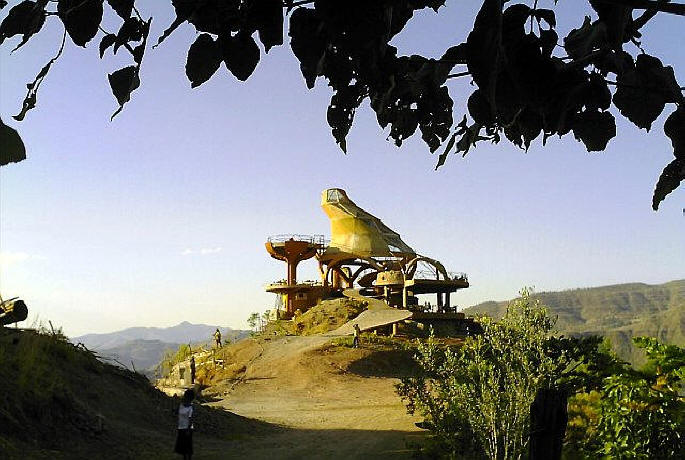
Lalibela Ethiopia: Another view of the Ben Abeba
Restaurant as seen along the half kilometer dirt
entry road near the junction with the dirt road
leading to the Mountain View Hotel where I stayed.
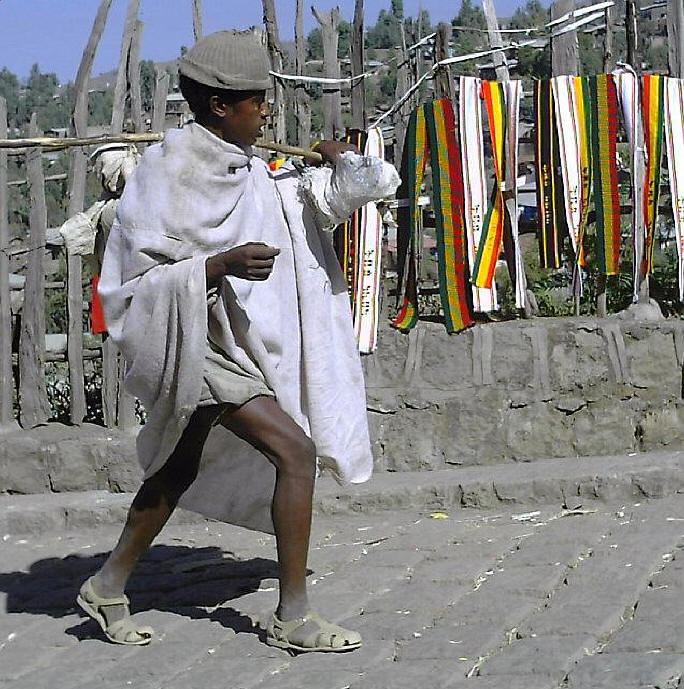
Lalibela Ethiopia: This young man seems to have his
hand in a plaster cast. I took the picture to show
how people typically carry their belongings in bundles hanging
from walking sticks over their shoulder.
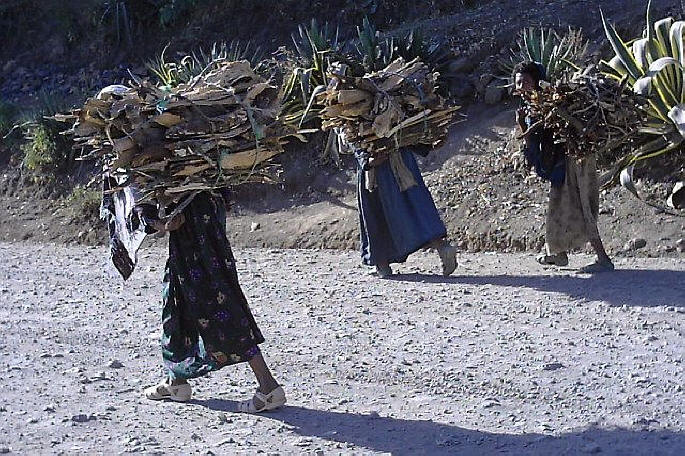
Lalibela Ethiopia: My camera is never ignored, even
by people engrossed in hard labor. These ladies
trudge up steep hills carrying bundles of sticks
from which they will make their cooking fires for a
few days, a scene repeated endlessly throughout my
stay in the area. People of all ages, both male and
female participate in this essential task.
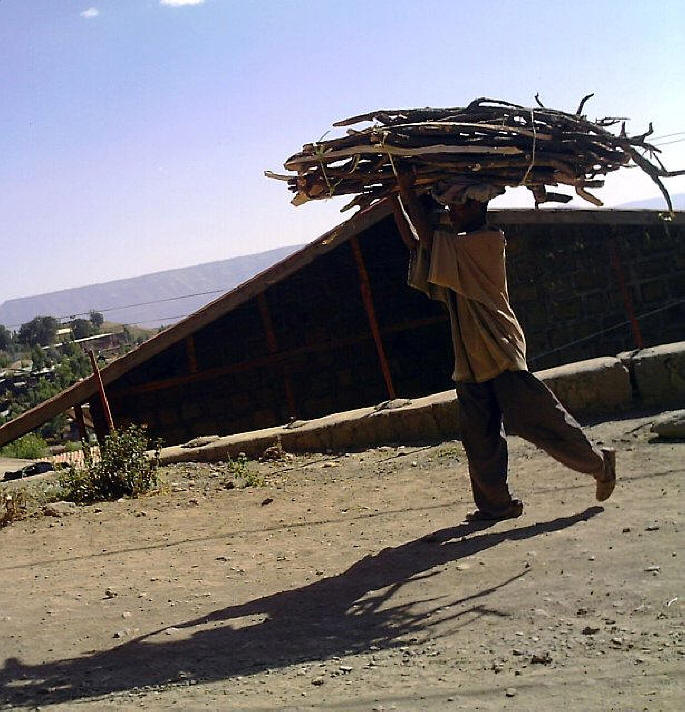
Lalibela Ethiopia: No one takes
fuel for granted here. This guy is carrying bundles
of firewood, a scene repeated endlessly throughout
my stay in the area. People of all ages, both male
and female participate in this essential task.
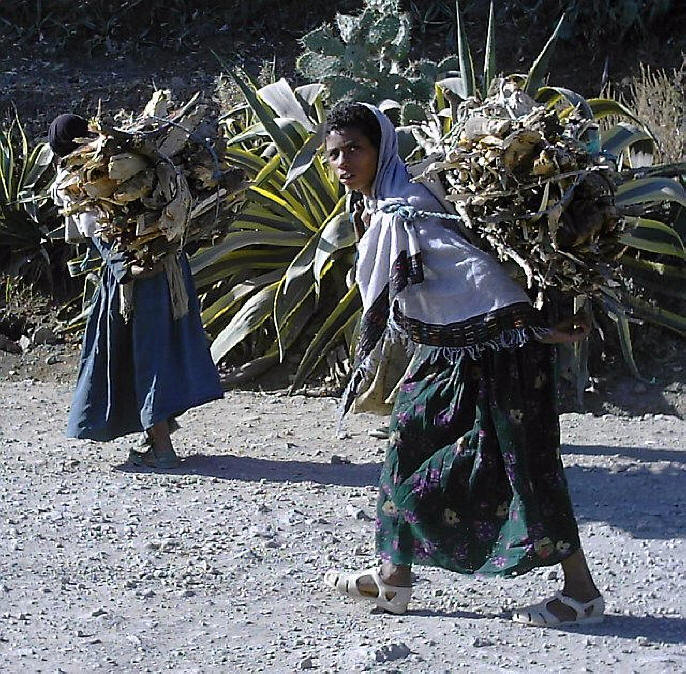
Lalibela Ethiopia: No one takes fuel for granted
here. These ladies trudge up steep hills carrying
bundles of sticks from which they will make their
cooking fires for a few days, a scene repeated
endlessly throughout my stay in the area. People of
all ages, both male and female participate in this
essential task.
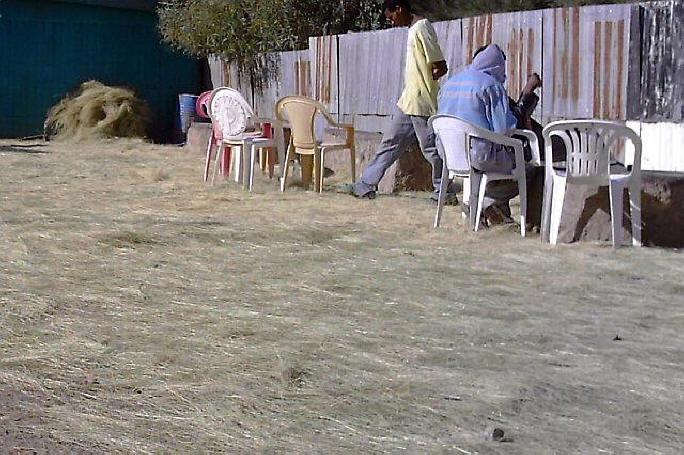
Lalibela Ethiopia: The first time I saw an area
covered with a layer of loose straw or dried grass I
thought it must be a way to just cover the dirt.
Later I learned it is a part of a solemn ritual
incorporated in the traditional
Coffee Ceremony
practiced throughout Ethiopia. I have now witnessed
several performances in hotels and airport departure
lounges.

Lalibela Ethiopia: Obama is a very popular name in
this part of Africa, too. Everyone brightens when
the name is mentioned, usually making some
complimentary comment about our president. In Kenya
Barack Obama's grandfather is a member of a tribe
that has never produced a president of Kenya, so a
popular joke goes that members of the Luo tribe must
immigrate to America to become president.

Lalibela Ethiopia: This photo is a good illustration
of just how steep is the road that runs along the
area where all the rock-hewn churches are located.
This is near the main entrance to the loosely
enclosed area and main ticket office where the 350
Birr or about $21 may be paid for the privilege of
entering all of the eleven churches to see their
dark cave-like interiors hacked out of the stone
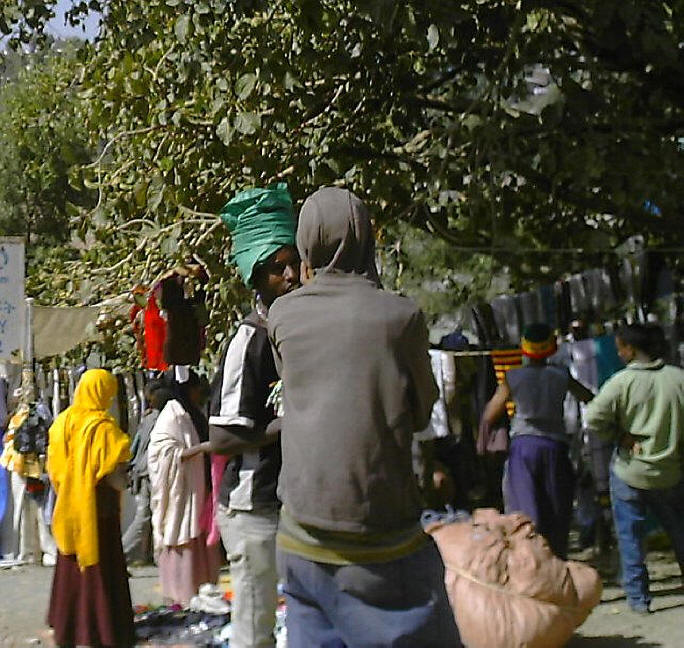
Lalibela Ethiopia: Crowds of local people inspect
merchandise along the main paved road that runs
through the area where all the rock-hewn churches
are located. When a foreign tourist appears, the
greetings in English start... and the begging.
Walking along the street I hear "Harrow, hello,
hello sir, hey you..." and other variants like echos
in a canyon. The small children are the most eager.
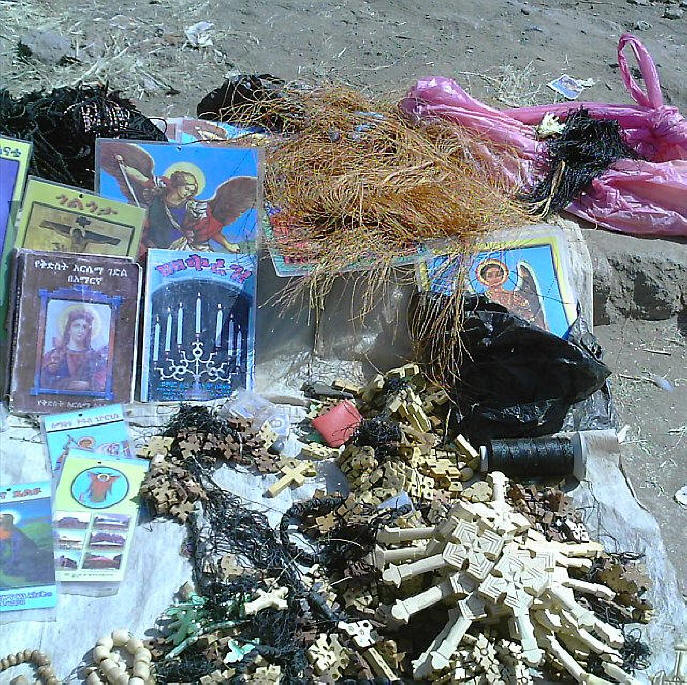
Lalibela Ethiopia: Religious artifacts like these
stylized wooden crosses and other souvenirs along
the main paved road that runs along the area where
all the rock-hewn churches are located.
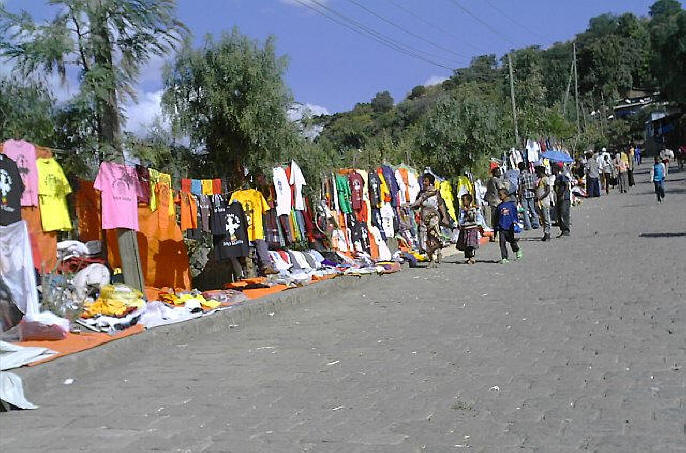
Lalibela Ethiopia: Locally produced clothing seems
to be popular with tourists along the main paved
road that runs along the area where all the
rock-hewn churches are located.
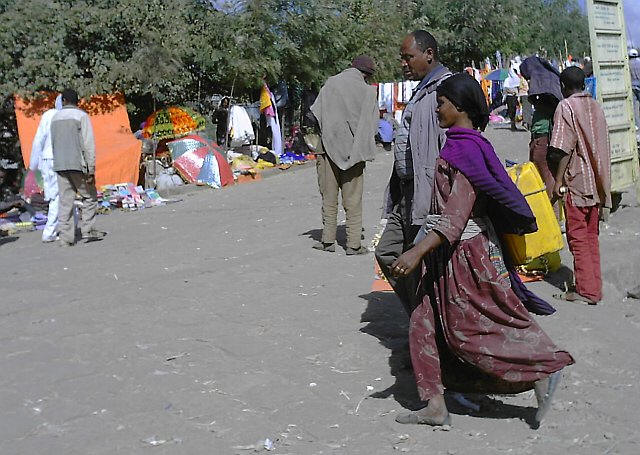
Lalibela Ethiopia: Scene along the main paved road that
runs along the area where all the rock-hewn churches are located. The
merchandise is primarily aimed at foreign tourists, but the area also serves
as a market for local people.
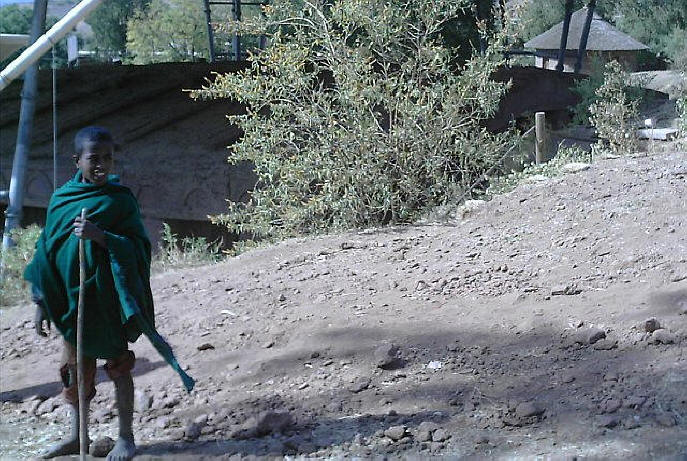
Lalibela Ethiopia: As I approached the main
archeological area with it's permanent protective
canopies covering the excavations boys like this one
started hounding me to offer their services as
guides. They had varying degrees of English language
skills, but all exhibited enormous enthusiasm...
probably motivated by the prospects of making BIG
money for their services with the RICH foreign
tourists.
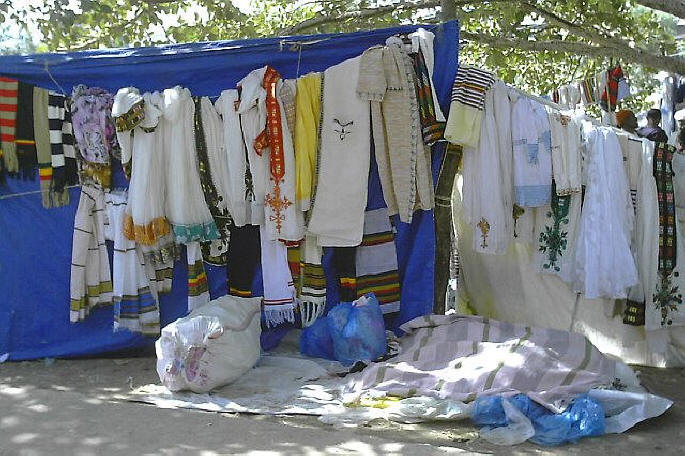
Lalibela Ethiopia: Locally produced clothing seems
to be popular with tourists along the main paved
road that runs along the area where all the
rock-hewn churches are located.
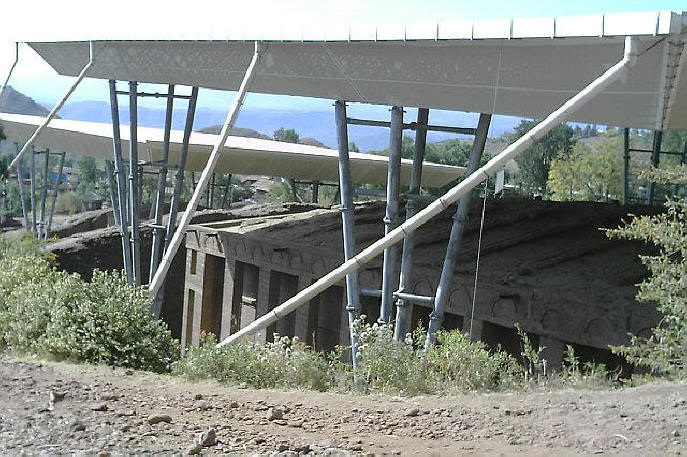
Lalibela Ethiopia: This is my first view of
rock-hewn structures as I approached the main
archeological area with it's permanent protective
canopies covering the excavations. This is one of
the eleven churches located at the northern end of
the cluster.
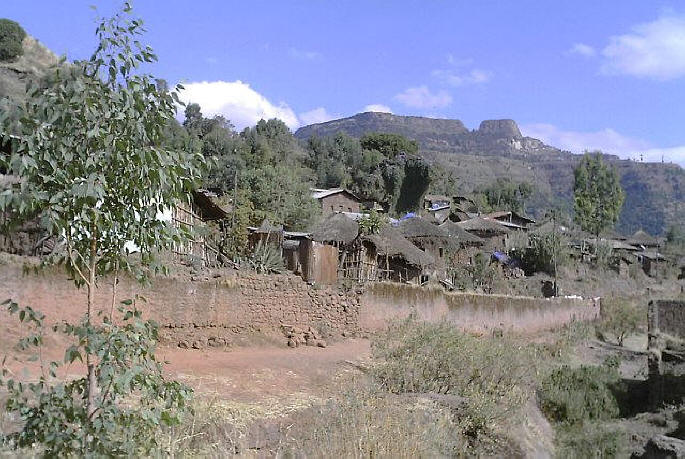
Lalibela Ethiopia: One of the typical villages
surrounding the main archeological area. I wandered
through such areas with impunity, generally without
any indication residents resented such intrusions.
Actually, quite a few people went out of their way
to greet me with friendly, though limited English
phrases like: "Hello... Welcome... Welcome to
Lalibela... Welcome to Thiopia..."... Note the silent "E."
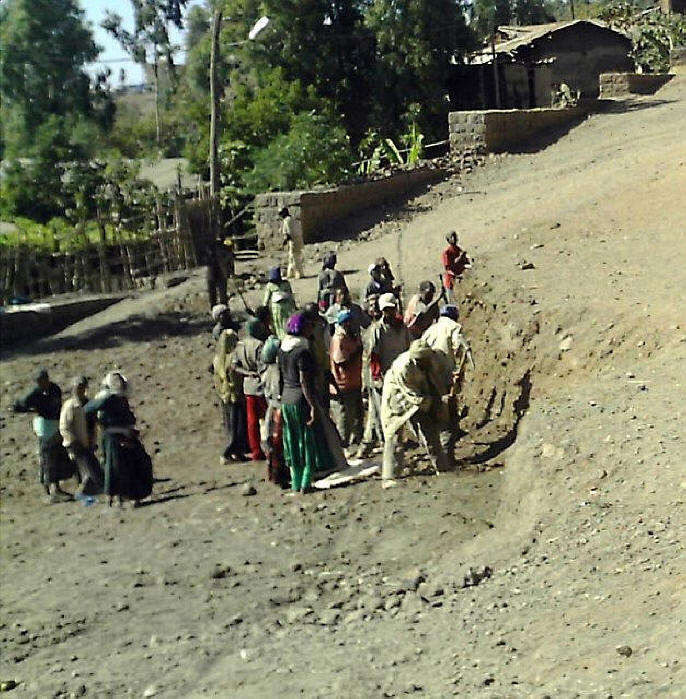
Lalibela Ethiopia: I watched
this road gang composed of both men and women slowly
carve a new graded turnoff road along the main road
connecting the Mountain View Hotel and the center of
town... and the main tourist area of rock-hewn
churches. Every time I passed we exchanged smiles
and greetings until the last day when the work
ended.
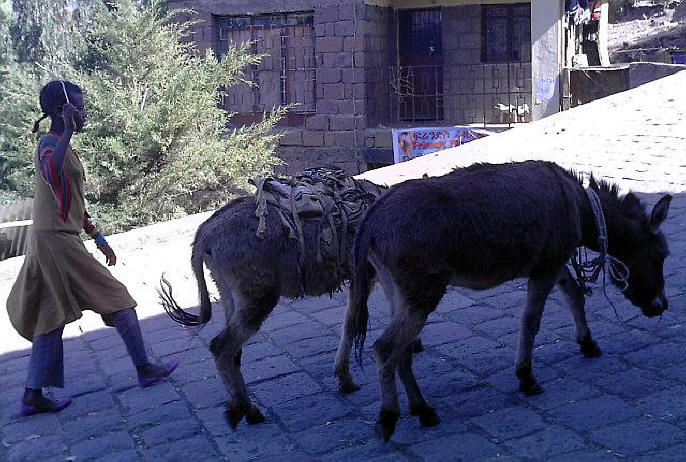
Lalibela Ethiopia: Their job done, this lady leads
her donkeys home for another load.
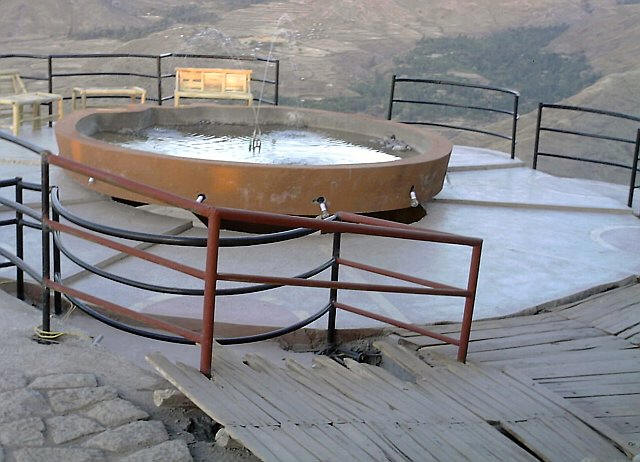
Lalibela Ethiopia: This is the open fountain
observation platform at the Ben Abeba Restaurant
enjoyed by guests during the pleasant parts of the
day. It also serves as the roof over the most unique
enclosures for toilets below. Winding walkways
spiral down to the lower level seemingly suspended
in space: careful in the dark or after too many
beers!
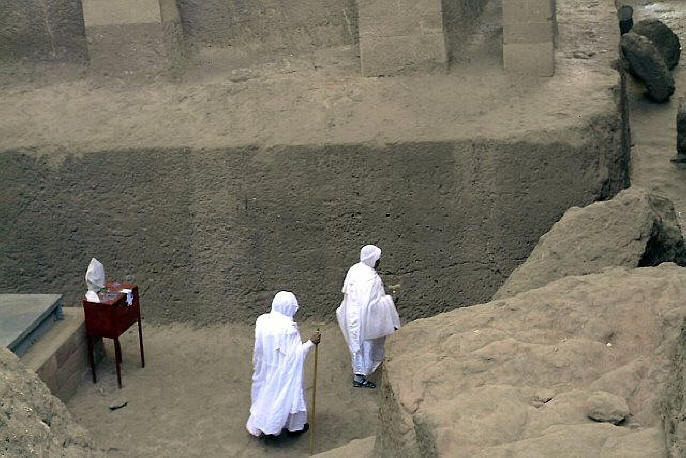
Lalibela Ethiopia: Pilgrims or priests approaching
the entrance to one of the eleven rock-hewn churches
located in this region.
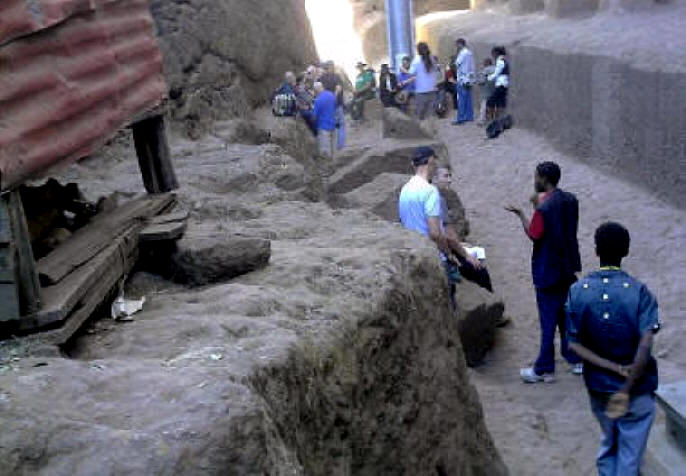
Lalibela Ethiopia: Government approved guides
lecture to groups of tourists near the entrance to
one of the eleven rock-hewn churches located in this
region.
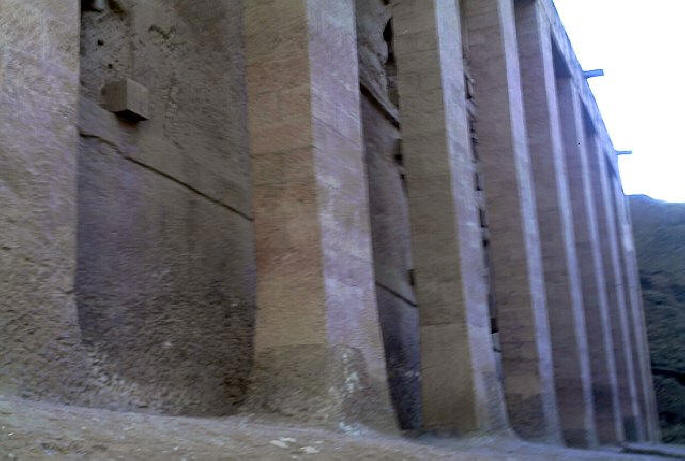
Lalibela Ethiopia: Details of sculptured pillars
along the wall of one of the eleven rock-hewn
churches located in this region.
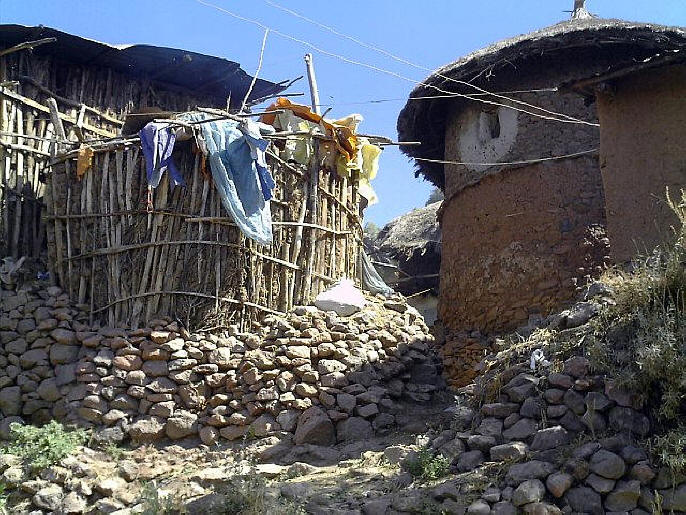
Lalibela Ethiopia: One of the villages located
immediately adjacent to one of the eleven rock-hewn
churches located in this region.
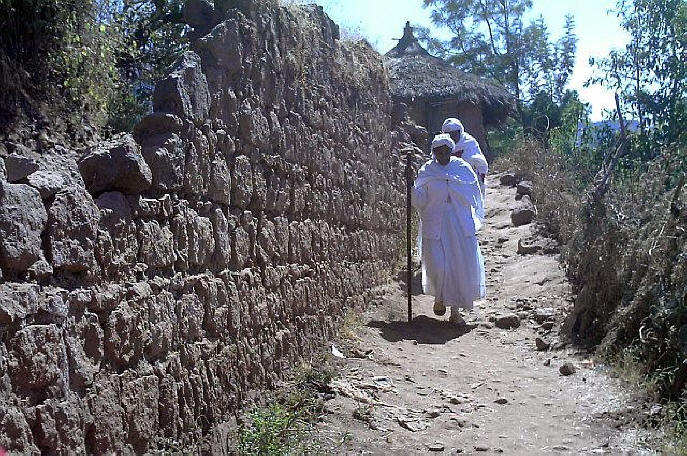
Lalibela Ethiopia: Villagers walk the path along a
wall enclosing one of the villages located
immediately adjacent to one of the eleven rock-hewn
churches located in this region.
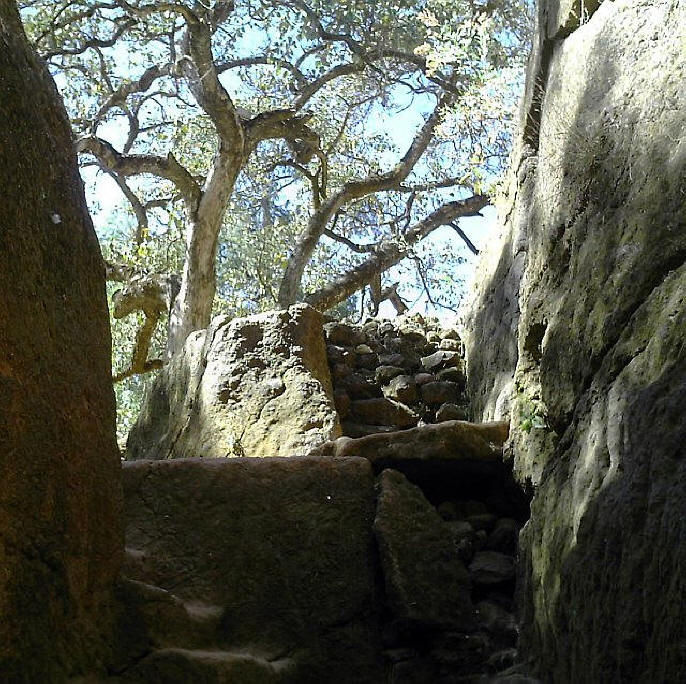
Lalibela Ethiopia: One of the surface entry points
into underground tunnels connecting the eleven
rock-hewn churches located in this region.
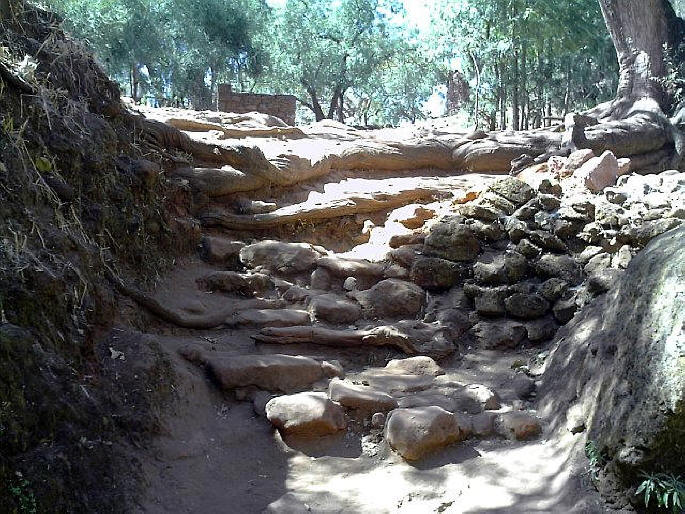
Lalibela Ethiopia: One of the surface entry points
into underground tunnels connecting the eleven
rock-hewn churches located in this region.
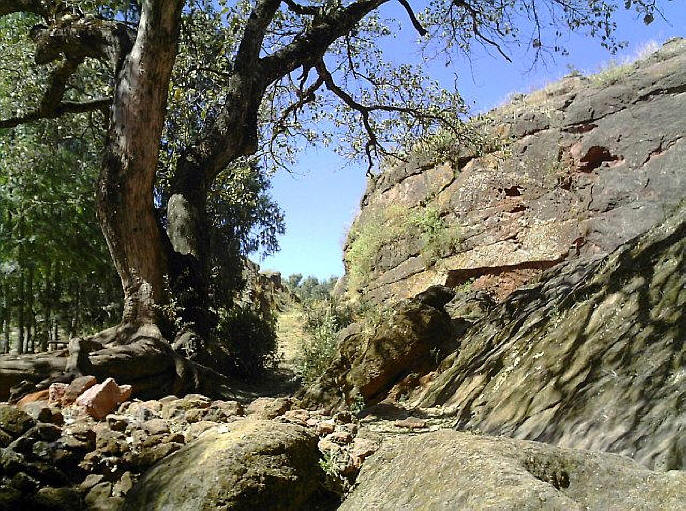
Lalibela Ethiopia: One of the surface entry points
into underground tunnels connecting the eleven
rock-hewn churches located in this region.
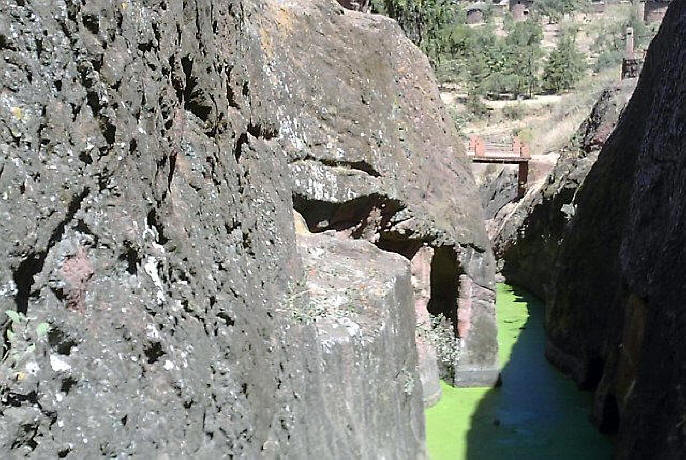
Lalibela Ethiopia: At certain times of the year
water floods some of the numerous tunnels and
trenches which connect many of the eleven rock-hewn
churches located in this region.

Lalibela Ethiopia: Local people climb steep paths
that connect many of the eleven rock-hewn churches
located in this region. Here a couple and their
heavily loaded donkeys reposition the load.
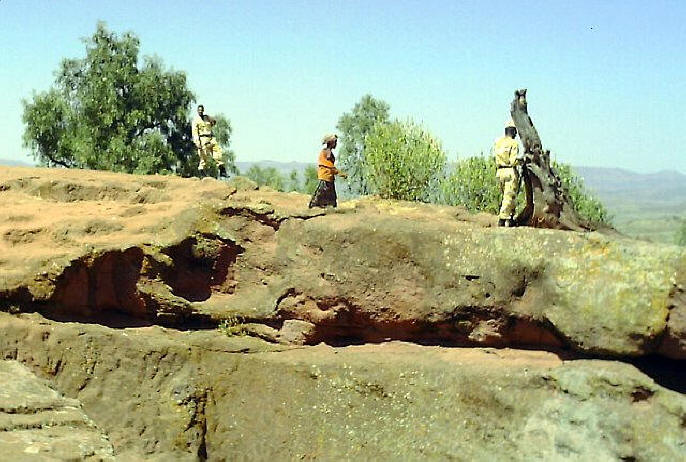
Lalibela Ethiopia: From this high vantage point
armed guards keep watch over the antiquities which
are a part of the eleven rock-hewn churches located
in this region.
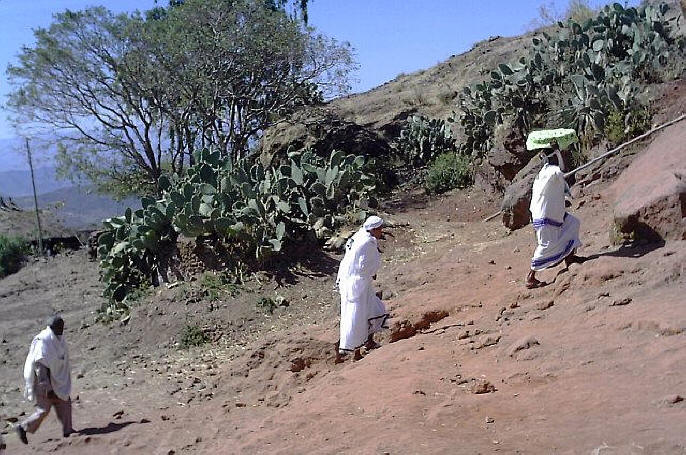
Lalibela Ethiopia: Local people climb steep paths
that connect many of the eleven rock-hewn churches
located in this region.
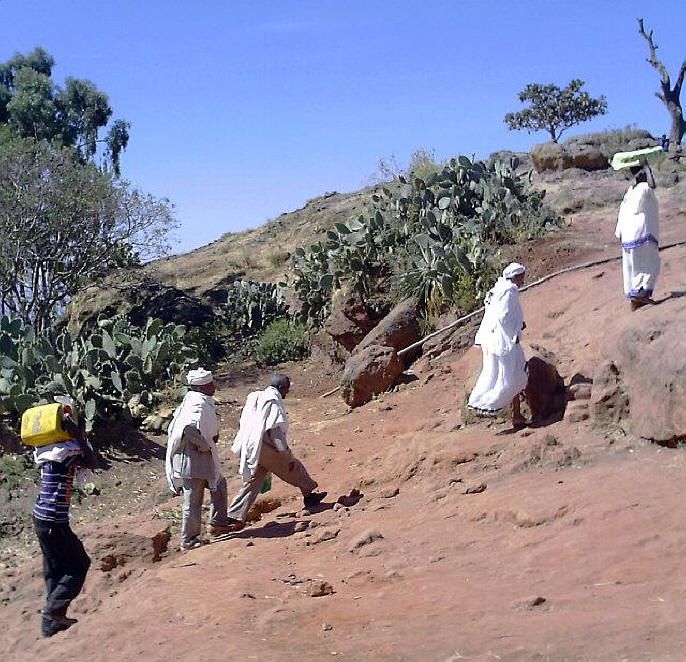
Lalibela Ethiopia: Local people climb steep paths
that connect many of the eleven rock-hewn churches
located in this region.
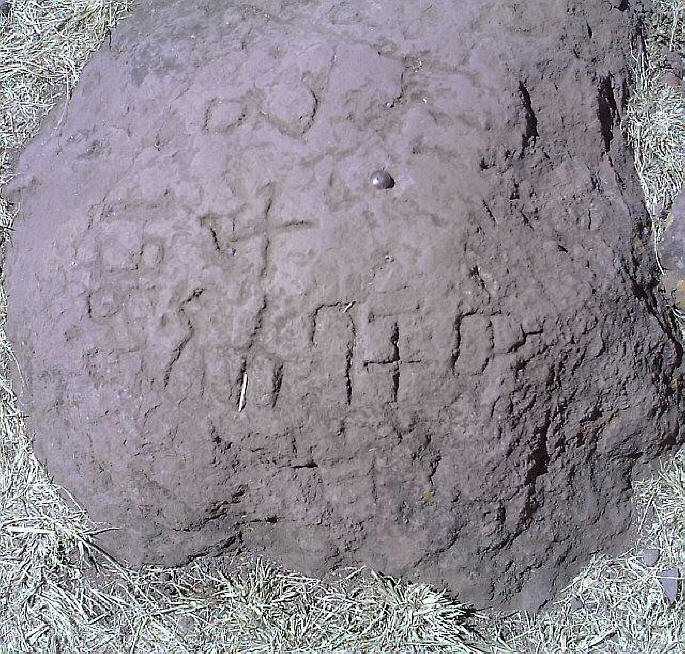
Lalibela Ethiopia: On a hill off the tourist paths
near one of the eleven rock-hewn churches located in
this region I came upon ancient graffiti carved into
some of the large stones like this one. The metal
peg in the rock might be a GPS marker.

Lalibela Ethiopia: Looking across the valley towards
some of the ancient excavations that form a part of
the eleven rock-hewn churches located in this
region.

Lalibela Ethiopia: Interesting tree sitting near one
of the eleven rock-hewn churches located in this
region. The dead branches above the green crown
serve as roosting places for a variety of birds.
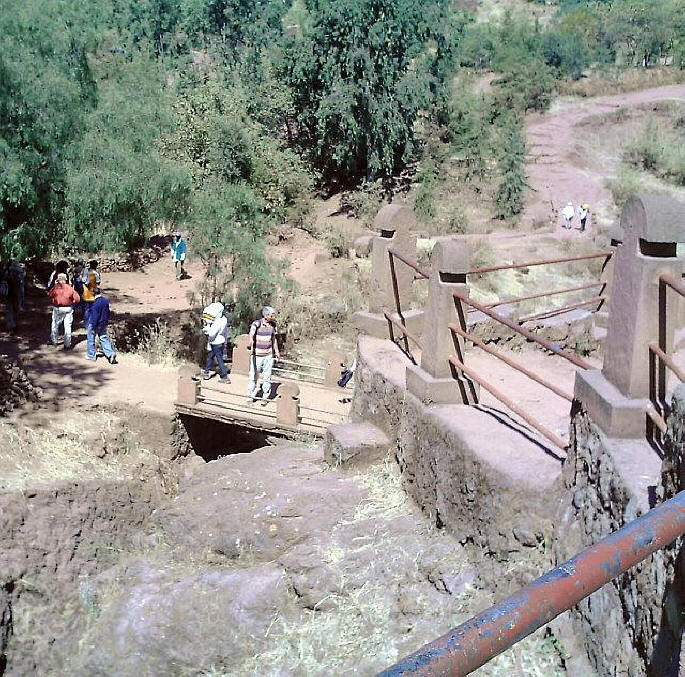
Lalibela Ethiopia: Bridges have been erected over
some of the numerous tunnels and trenches which
connect many of the eleven rock-hewn churches
located in this region.
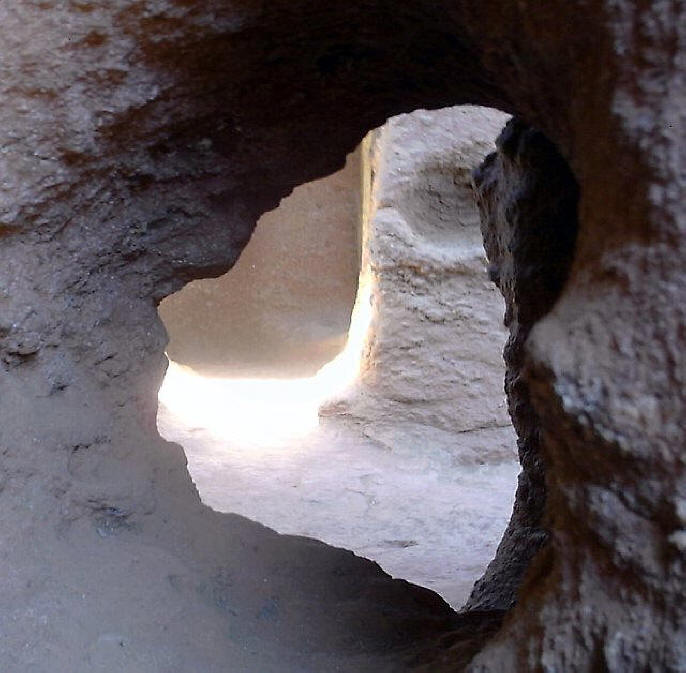
Lalibela Ethiopia: Numerous tunnels and trenches
connect many of the eleven rock-hewn churches
located in this region.
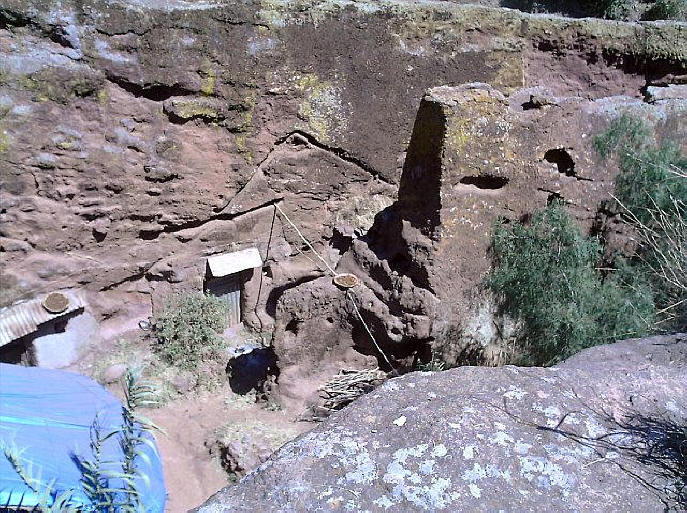
Lalibela Ethiopia: Looking down into the wide trench
surrounding one of the eleven rock-hewn churches
located in this region. People have build homes
among some of the ruins like here.
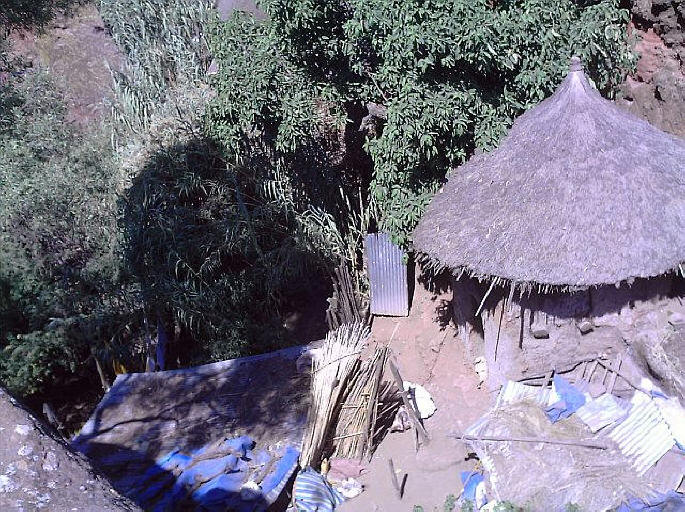
Lalibela Ethiopia: Looking down into the wide trench
surrounding one of the eleven rock-hewn churches
located in this region. People have build homes
among some of the ruins like here.
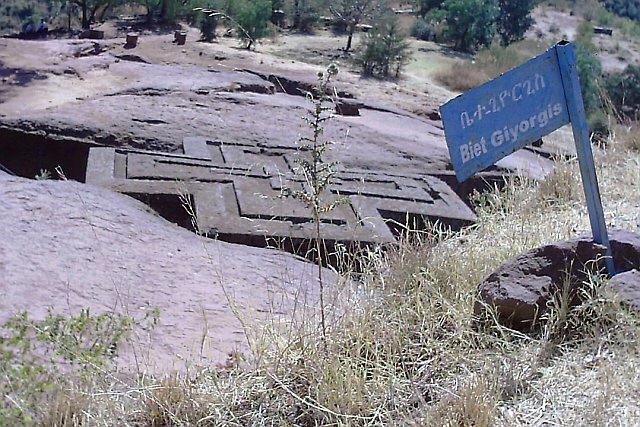
Lalibela Ethiopia: First view seen by visitors of
the Biet Giyougis or Church of St. George, the most
famous of the eleven rock-hewn churches located in
this region.
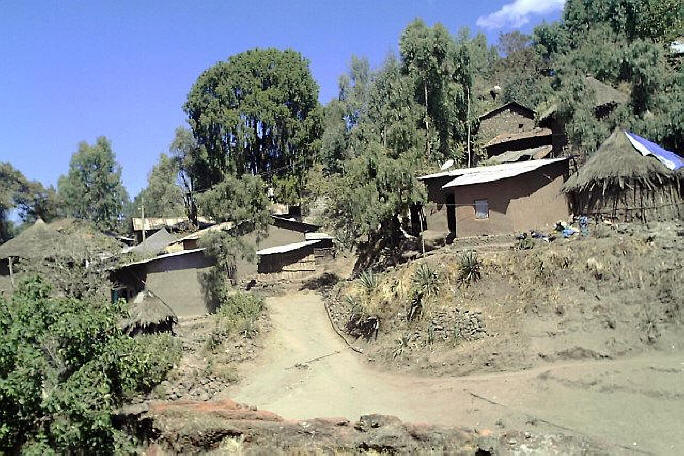
Lalibela Ethiopia: One of the villages located
immediately adjacent to one of the eleven rock-hewn
churches located in this region.
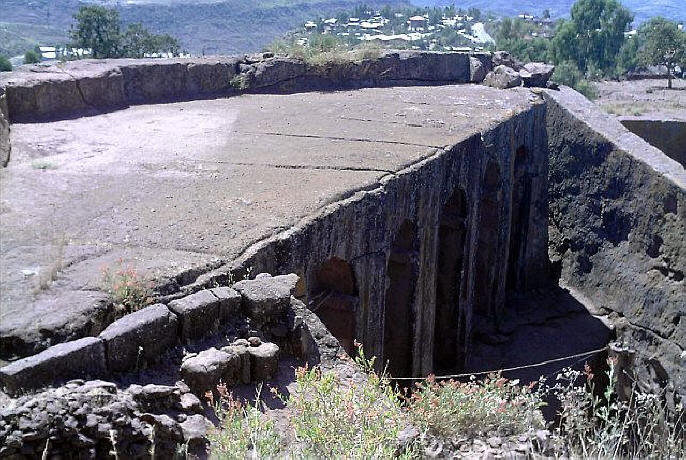
Lalibela Ethiopia: Looking down into the trench
surrounding one of the eleven rock-hewn churches
located in this region.
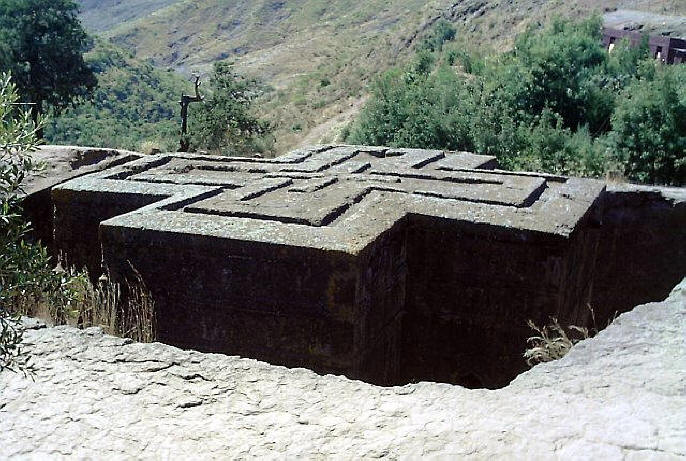
Lalibela Ethiopia: Yet another view of the Biet
Giyougis or Church of St. George, the most famous of
the eleven rock-hewn churches located in this
region. I took a lot of photos as I circumambulated
this iconic structure as I'll never be here again.
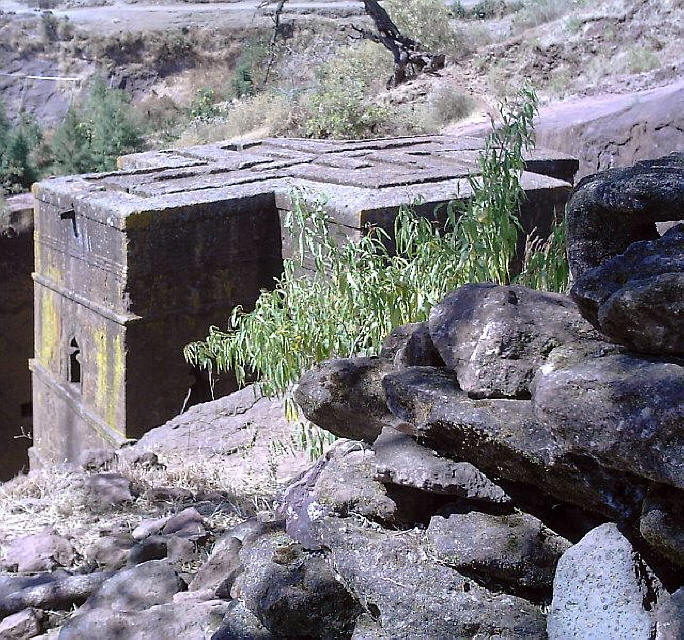
Lalibela Ethiopia: Another view of the Biet Giyougis
or Church of St. George, the most famous of the
eleven rock-hewn churches located in this region. I
took a lot of photos as I circumambulated this
iconic structure as I'll never be here again.
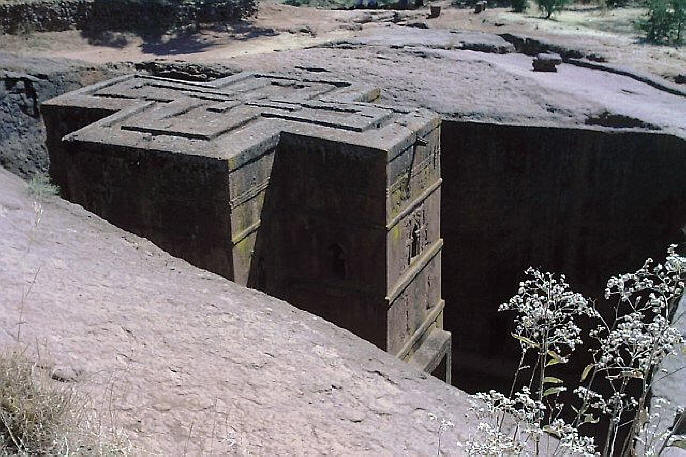
Lalibela Ethiopia: First view seen by visitors of
the Biet Giyougis or Church of St. George, the most
famous of the eleven rock-hewn churches located in
this region.
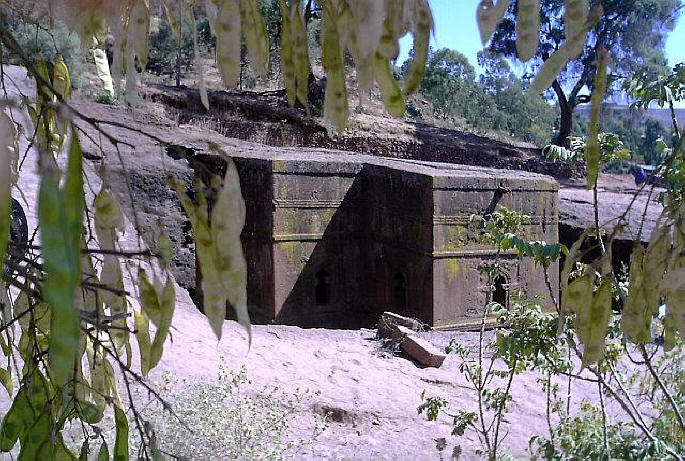
Lalibela Ethiopia: Another view seen by visitors of
the Biet Giyougis or Church of St. George, the most
famous of the eleven rock-hewn churches located in
this region.
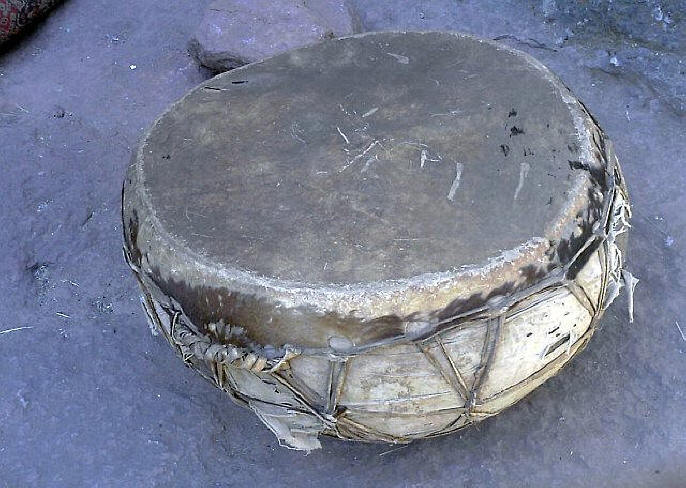
Lalibela Ethiopia: Ceremonial drum sitting in the
trench surrounding the Biet Giyougis or Church of
St. George, the most famous of the eleven rock-hewn
churches located in this region.

Lalibela Ethiopia: Looking back towards the entry
path leading to the Biet Giyougis or Church of St.
George, the most famous of the eleven rock-hewn
churches located in this region.
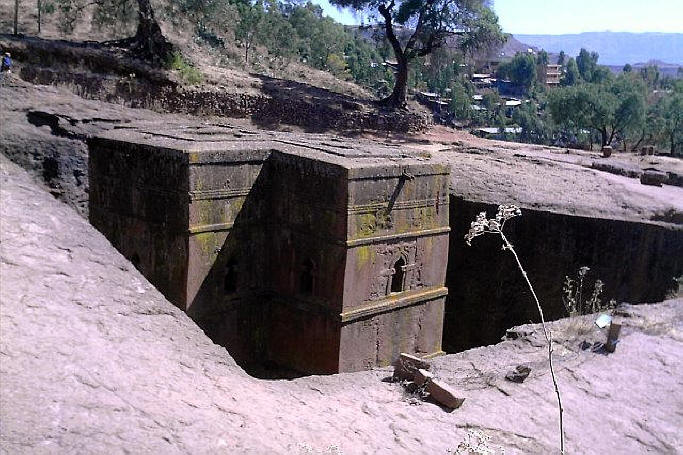
Lalibela Ethiopia: Another view seen by visitors of
the Biet Giyougis or Church of St. George, the most
famous of the eleven rock-hewn churches located in
this region.
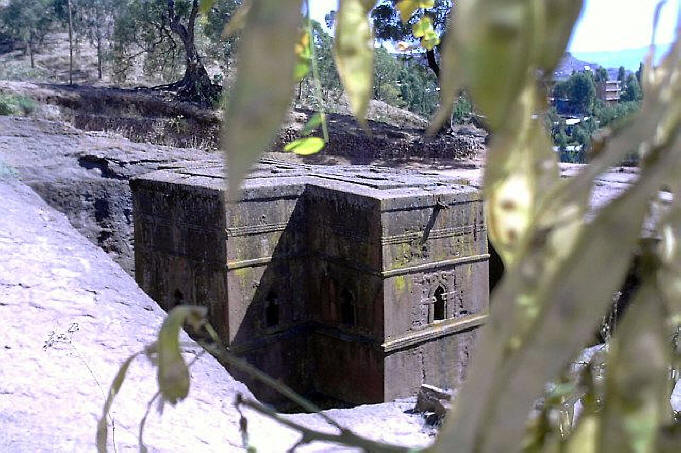
Lalibela Ethiopia: Another view seen by visitors of the Biet Giyougis or
Church of St. George, the most famous of the eleven rock-hewn churches
located in this region.
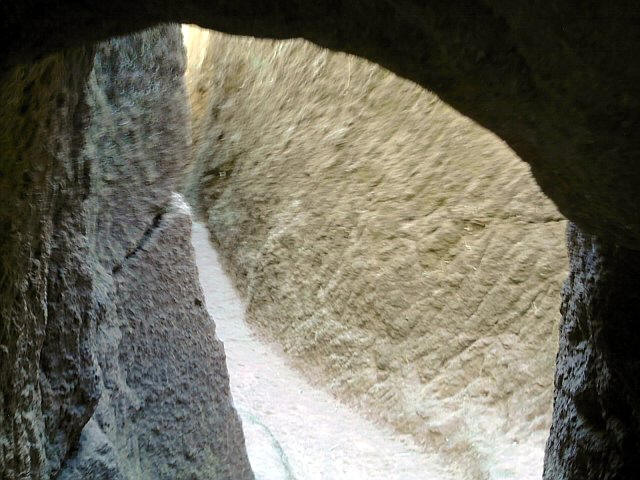
Lalibela Ethiopia: Another of the many tunnels
connecting the eleven rock-hewn churches located in this region.
|
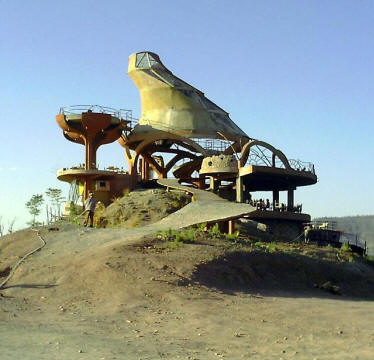
Lalibela Ethiopia: Ben Abeba Restaurant as seen from the arrival point along
the half kilometer dirt entry road not far from the junction with the dirt
road leading to the Mountain View Hotel where I stayed. Still under
development, it is never-the-less more than ready to serve its guests with
refinements unexpected outside Paris!
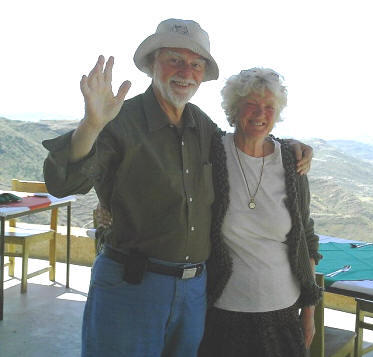
Lalibela Ethiopia: This is Susan, a sixty something Scottish woman who
decided several years ago that Lalibela needed at least one gourmet
restaurant and found an Ethiopian partner who agreed to develop the Ben
Abeba Restaurant with her. When I confessed my suspicion she was a former
hippie like me, she coyly declined to deny it.
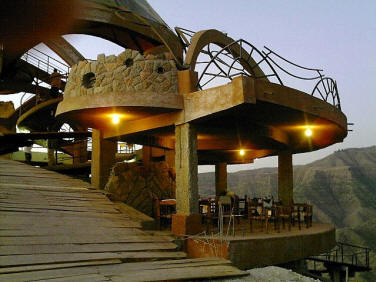
Lalibela Ethiopia: Ben Abeba Restaurant at dusk as seen from the edge of the
steep entry ramp. The remarkable architecture is only the first delightful
characteristic of this innovative island of civility here in the middle of
dust and primitive refinements.
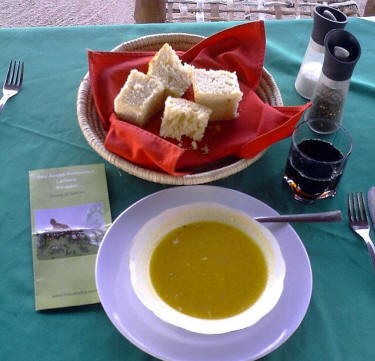
Lalibela Ethiopia: Starters for one of my meals at the Ben Abeba Restaurant.
Home made bread from their own ovens tasted so good I took the left overs
back to the hotel for an evening snack. The cream corn soup could have been
a meal in itself: delicious!
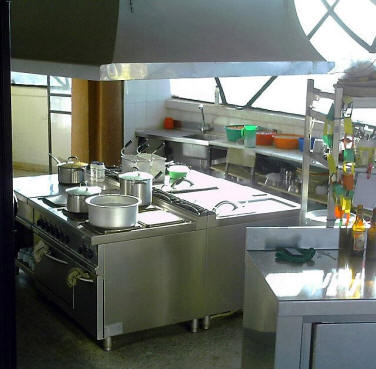
Lalibela Ethiopia: Another view of the ultra modern kitchen unrivaled by
most fine establishments in Europe or America, a principle goal of the
owner, Susan when she established the specifications for the new place.
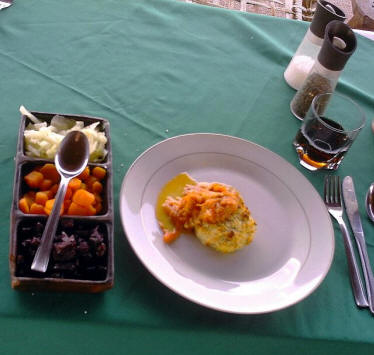
Lalibela Ethiopia: This tuna croquet and garden fresh vegetables meal
satisfied like it came from a French restaurant in Paris! The Ben Abeba
Restaurant has achieved standards unexpected in this mostly primitive, dusty part
of Ethiopia. What a surprising delight!
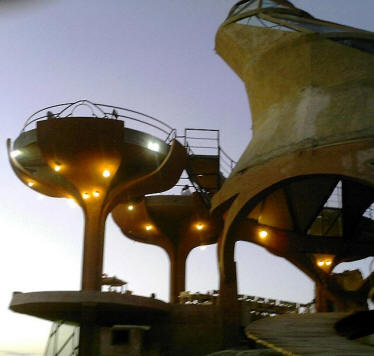
Lalibela Ethiopia: One of the several covered dining platforms at the Ben
Abeba Restaurant as seen from the entry ramp at dusk. Above are more dining
areas open to the sky. They remind me of giant Champaign glasses full of the
bubbly.
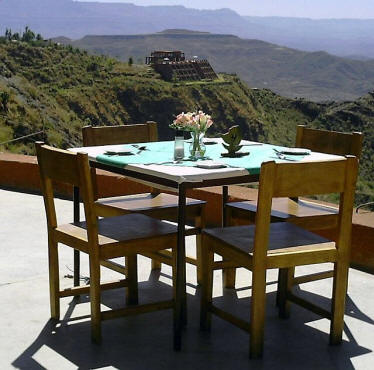
Lalibela Ethiopia: This is one of the open West facing dining areas where I
enjoyed a lunch one day at the Ben Abeba Restaurant. The Mountain View Hotel
where I stayed can be seen in the distance.
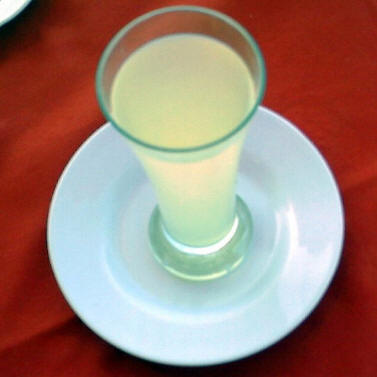
Lalibela Ethiopia: Irresistible fresh home made lemonade reminded me of
grandma and my childhood. I can't remember enjoying a glass more than this
one with the endless dusk vistas stretching out to the western horizon. This
glass will always remind me of the open West facing dining area where I
enjoyed it one afternoon at the fabulous Ben Abeba Restaurant in Lalibela
Ethiopia.
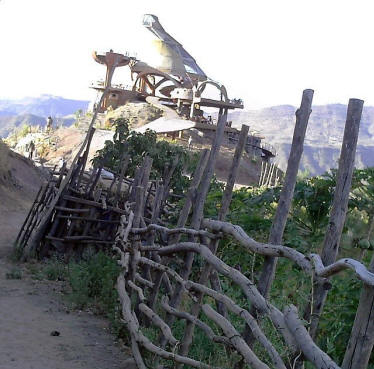
Lalibela Ethiopia: A view of the Ben Abeba Restaurant as seen from the
rustic fence lined half kilometer dirt entry road.

Lalibela Ethiopia: Ben Abeba Restaurant as seen along the half kilometer
dirt entry road near the junction with the dirt road leading to the Mountain
View Hotel where I stayed.
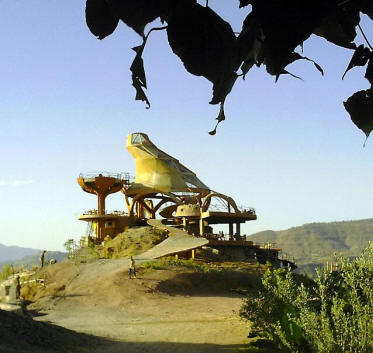
Lalibela Ethiopia: An iconic view of the Ben Abeba Restaurant as seen from
the half kilometer dirt entry road not far from the junction with the dirt
road leading to the Mountain View Hotel where I stayed.
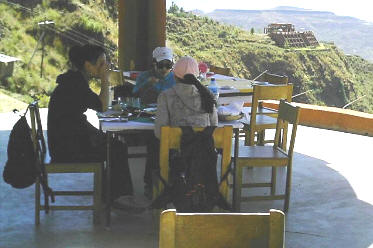
Lalibela Ethiopia: This is one of the open West facing dining areas where I
enjoyed a lunch one day at the Ben Abeba Restaurant. The Mountain View Hotel
where I stayed can be seen in the background, about a twenty minute walk
from the restaurant. The three Korean girls shown here also were guests at
my hotel and took an interest in my website when I showed it to them.
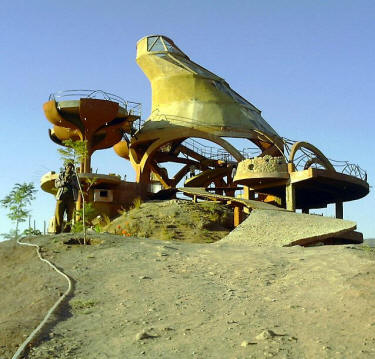
Lalibela Ethiopia: A yet closer view of the still unfinished Ben Abeba Restaurant as seen
from the half kilometer dirt entry road.
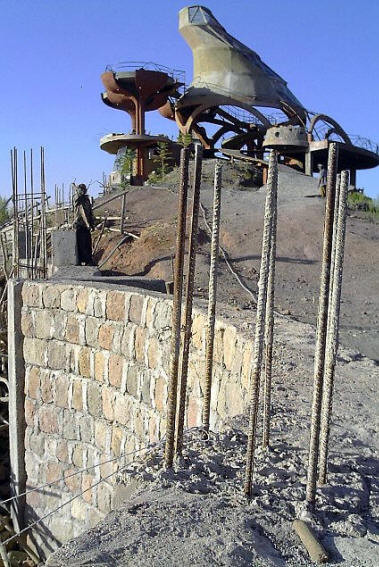
Lalibela Ethiopia: Ben Abeba Restaurant as seen from what appears to be
modern huts being built in the old traditional round design on adjacent
property.
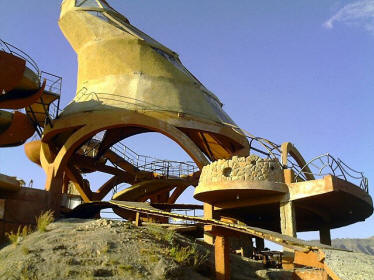
Lalibela Ethiopia: And a still yet closer look at the dining platforms
facing East at the Ben Abeba Restaurant as seen from the half kilometer dirt
entry road.
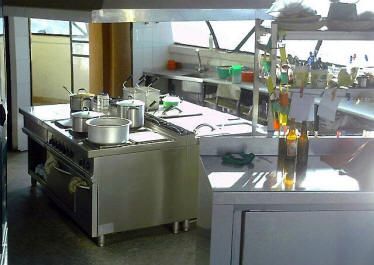
Lalibela Ethiopia: A view of the ultra modern kitchen unseen from outside
the Ben Abeba Restaurant. Well trained local young people observe modern
hygiene practices and gourmet cuisine art. The owner, Susan calls them her "chefettes."
Both meals I enjoyed at the restaurant made me want to return, especially
considering the very reasonable prices and gracious hospitality.
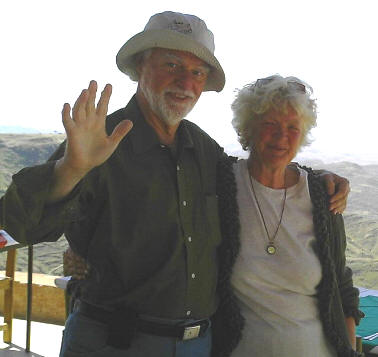
Lalibela Ethiopia: This is Susan, a sixty something Scottish woman who
decided several years ago that Lalibela needed at least one gourmet
restaurant and found an Ethiopian partner who agreed to develop the Ben
Abeba Restaurant with her. When I confessed I suspected she was a former
hippie like me, she refused to deny it.
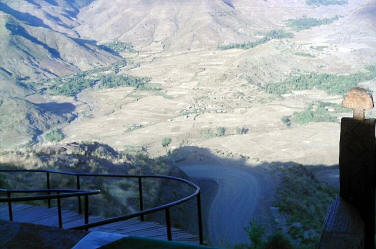
Lalibela Ethiopia: A view looking east from one of the dining platforms at
the Ben Abeba Restaurant. Everyone of the half dozen dining platforms has an
unobstructed view of the surrounding countryside; some are covered while
others are open to the sky.
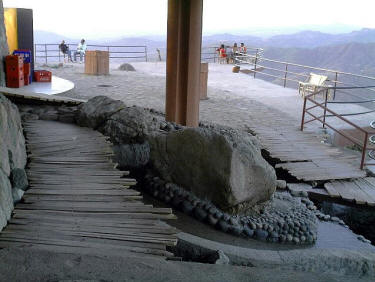
Lalibela Ethiopia: One of the open observation platforms at the Ben Abeba
Restaurant favored by guests for lingering over a cup of coffee hand made by
a staff member performing the traditional Ethiopian Coffee Ceremony... or
sipping a bottle of beer.
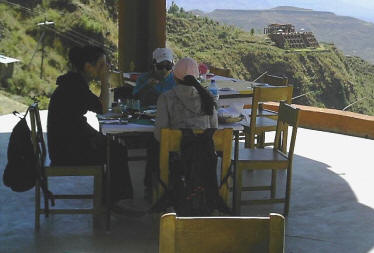
Lalibela Ethiopia: This is one of the open West facing dining areas where I
enjoyed a lunch one day at the Ben Abeba Restaurant. The Mountain View Hotel
where I stayed can be seen in the background, about a twenty minute walk
from the restaurant. The three Korean girls shown here also were guests at
my hotel and took an interest in my website when I showed it to them.
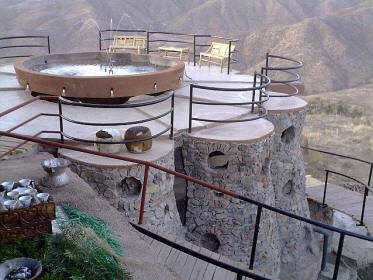
Lalibela Ethiopia: This is the open fountain observation platform at the Ben
Abeba Restaurant enjoyed by guests during the pleasant parts of the day. It
also serves as the roof over the most unique enclosures for toilets below.
Winding walkways spiral down to the lower level seemingly suspended in
space: careful in the dark or after too many beers!
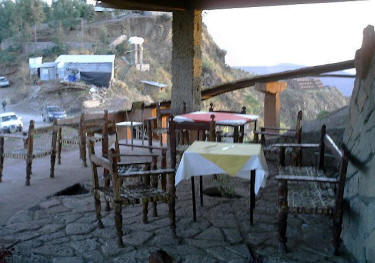
Lalibela Ethiopia: This is one of the covered East facing dining areas where
I enjoyed a lunch one day at the Ben Abeba Restaurant.
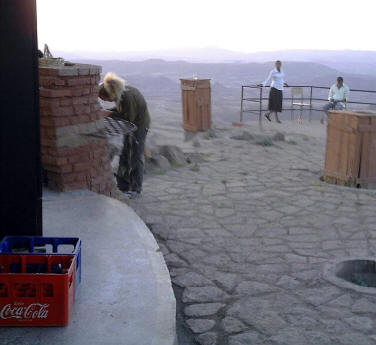
Lalibela Ethiopia: Another of the open observation platforms at the Ben
Abeba Restaurant favored by guests for lingering over a cup of coffee hand
made by a staff member performing the traditional Ethiopian Coffee
Ceremony... or sipping a bottle of beer.
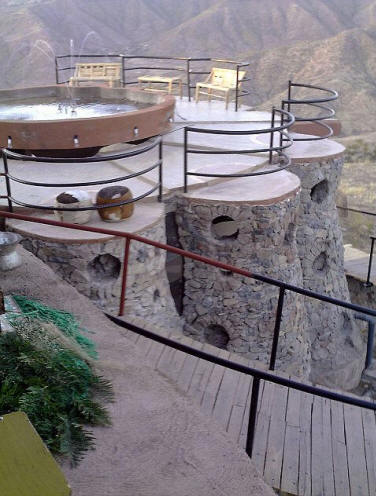
Lalibela Ethiopia: This is the open fountain observation platform at the Ben
Abeba Restaurant enjoyed by guests during the pleasant parts of the day. It
also serves as the roof over the most unique enclosures for toilets below.
Winding walkways spiral down to the lower level seemingly suspended in
space: careful in the dark or after too many beers!
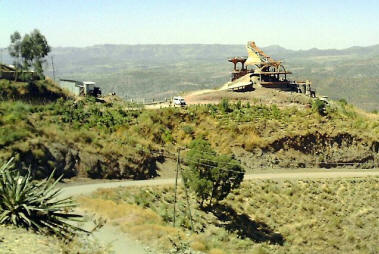
Lalibela Ethiopia: Ben Abeba Restaurant as seen from the main road (dirt)
running through Lalibela. At this point it is not obvious how one might
reach the remote structure.
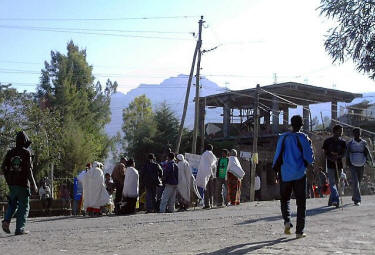
Lalibela Ethiopia: This is the first sight I see when the airport shuttle
taxi drops me off in the "center" of town. There is not much here and the
entire extent of the "city" covers no more than a kilometer along the main
paved road which becomes dirt after that.
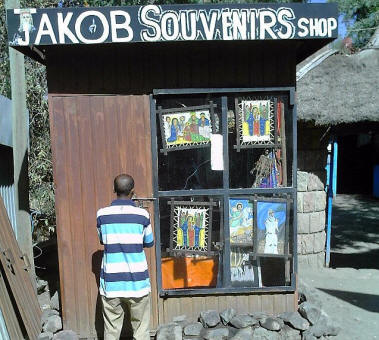
Lalibela Ethiopia: Several curio shops like this one vie for customers near
the center of the village.
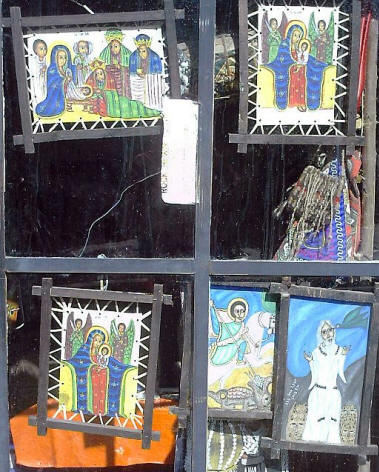
Lalibela Ethiopia: Several curio shops like this one vie for customers near
the center of the village. The art here attracted my attention.
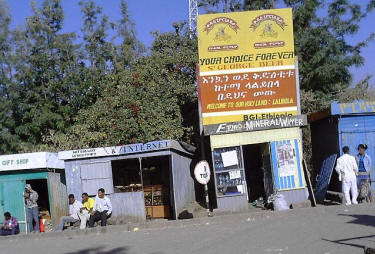
Lalibela Ethiopia: This is the first sight I see on the other side of the
road in the center of town. There is not much here and the entire extent of
the "city" covers no more than a kilometer along the main paved road.
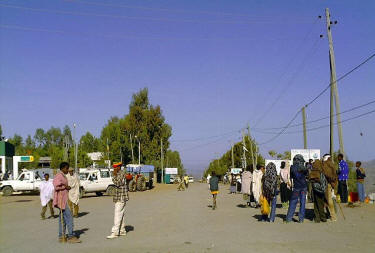
Lalibela Ethiopia: This is what I see looking on down the main road through
the center of town. There is not much here.
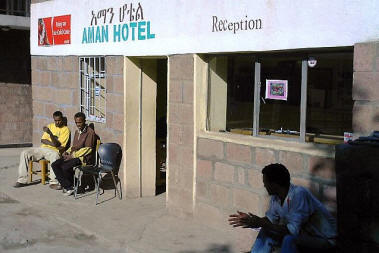
Lalibela Ethiopia: Entrance to reception at the Aman Hotel. At $40 it would
have met my minimum standards, but I trudged on for more choices and to
check out the "best hotel in Lalibela," the Mountain View where I eventually
ended up.
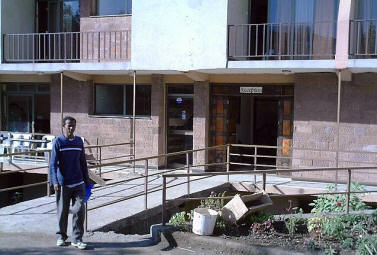
Lalibela Ethiopia: Entrance to the Aman Hotel in the very center of the town
and right next to the only bank in the region. Before leaving, this young
man showed me how they could provide WiFi Internet connection with a 3G
dongle.
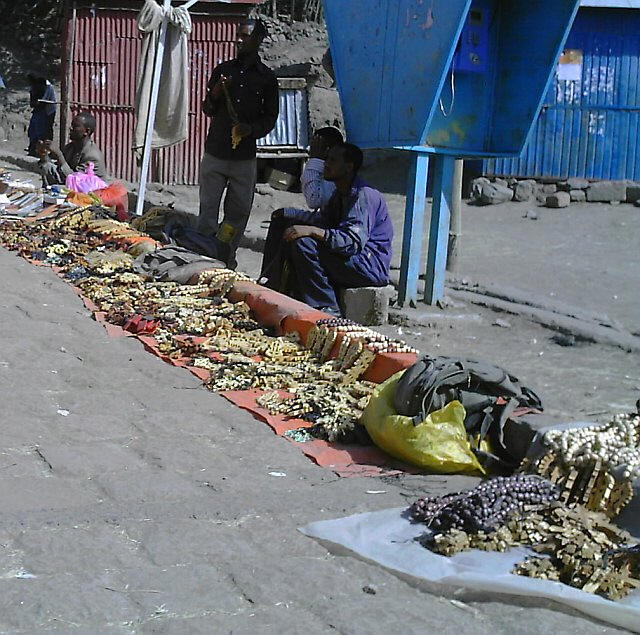
Lalibela Ethiopia: Scene along the steep main paved road that runs along the
area where all the rock-hewn churches are located. The merchandise is
primarily aimed at foreign tourists, but the area also serves as a market
for local people.
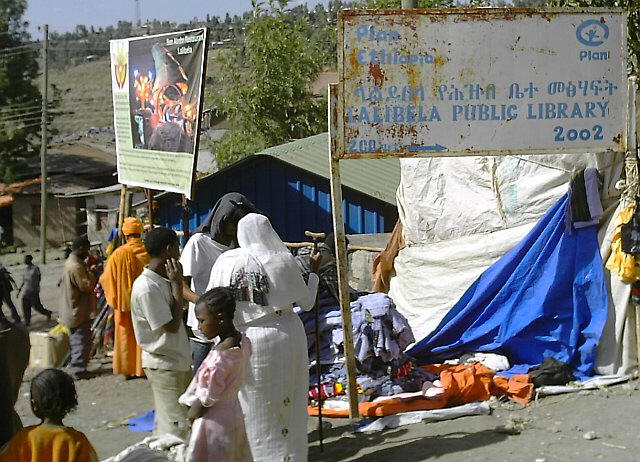
Lalibela Ethiopia: I took this photo to record the sign designating the
location of the Lalibela Public Library located along the main paved road
that runs along the area where all the rock-hewn churches are located.
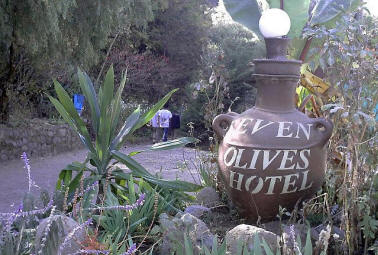
Lalibela Ethiopia: Entrance to the Seven Olives Hotel, one of the other
lodges often recommended in guide books for this area. The interesting
entrance suggests a lot more quality than is evident beyond this point.
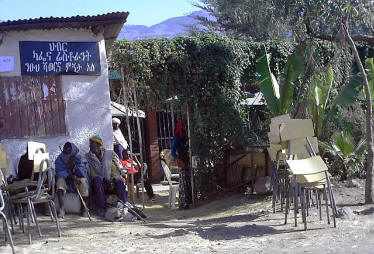
Lalibela Ethiopia: This is some of the commercial activity in the center of
the town.
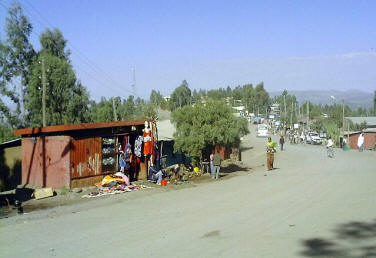
Lalibela Ethiopia: Some of the stores near the center of the village at the
junction road leading down to the $64 Mountain View Hotel a couple
kilometers distant where I stayed three nights.
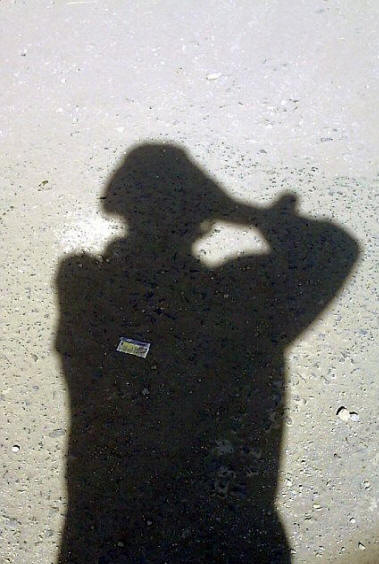
Lalibela Ethiopia: The paved "highway" from the airport continues a few
hundred meters beyond the center of town and abruptly ends right here where
the shadow of my head is. Standing here one day I watched as about fifteen
young decorated warriors shared the effort of carrying a litter with an
elderly woman on it, presumably ill and on the way to the only hospital
within a hundred kilometers.
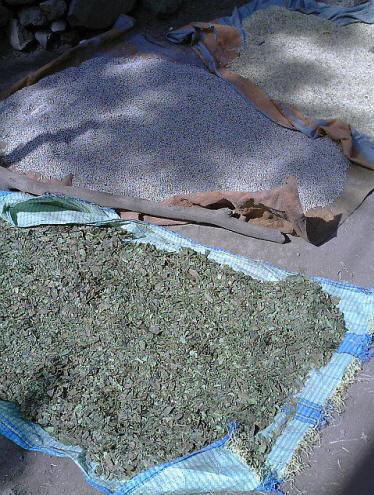
Lalibela Ethiopia: Traditional huts forming villages surround the area of
the rock-hewn churches and local people get on with their lives despite the
hoards of tourists and pilgrims visiting their neighborhoods. Here, barley,
wheat and crumbled
injera dry in the sun outside a family's hut.
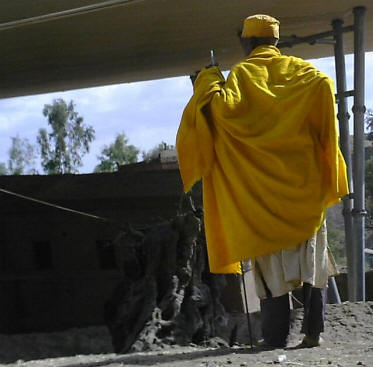
Lalibela Ethiopia: Standing at the edge of one of the canopy covered
rock-hewn structures this priest meditates on the historical significance of
the ancient religious traditions. I watch him for ten minutes snapping a
steady stream of pictures in the hope he might eventually turn around. He is
one of many such priests one sees around the churches, some in white
garments of their Order.
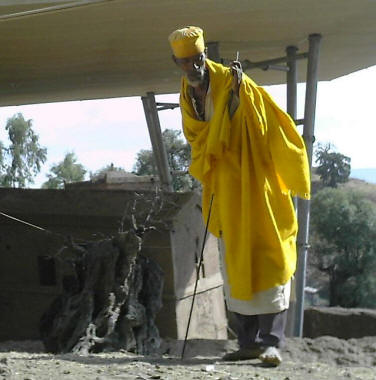
Lalibela Ethiopia: After this priest meditates on the historical
significance of the ancient religious traditions for several minutes he
turns around and I grab another picture. He seems to notice me and adjusts
his posture for a more dignified appearance... or to approach for a
donation... some did.
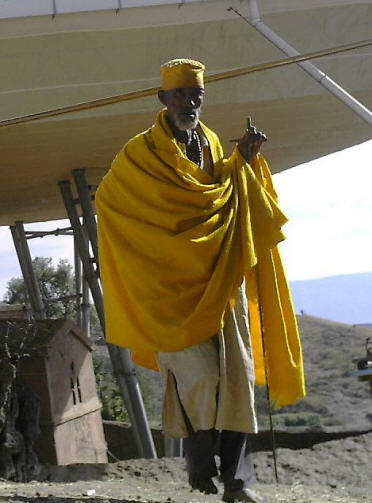
Lalibela Ethiopia: This priest now definitely takes notice of my attention
and poses with his crucifix staff. His expression is hard to read. Does he
resent my clandestine photographic efforts or is he displaying a
disinterested reverie? I speak no Amharic so I'll never know.
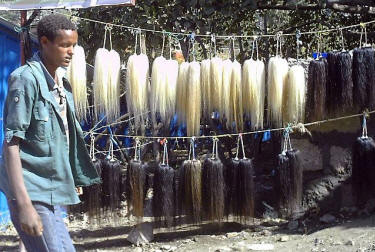
Lalibela Ethiopia: Fly swatters on display along the road. Local people as
well as tourists shop for things here.
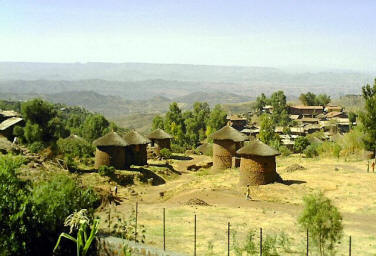
Lalibela Ethiopia: One of the traditional village clusters near the archeological
site.
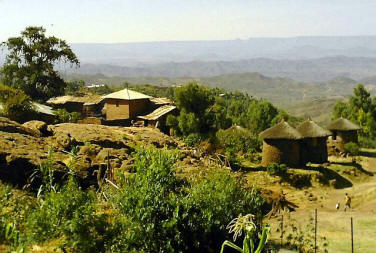
Lalibela Ethiopia: One of the traditional villages near the archeological
site.
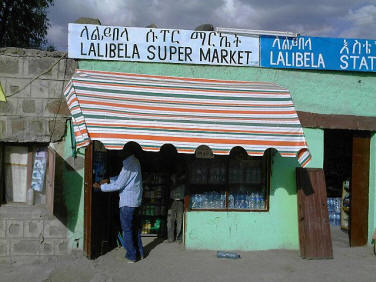
Lalibela Ethiopia: O.K. This is no "super" market,
but it is the closest thing to one the village of
Lalibela has to offer. Essentials like bottled
drinking water, packaged biscuits, soft drinks and
cooking oil stacked both on dusty shelves and the
dirt floor of the store satisfied basic needs. Here
I discovered CoffeeCola, a delicious "new" soft
drink.
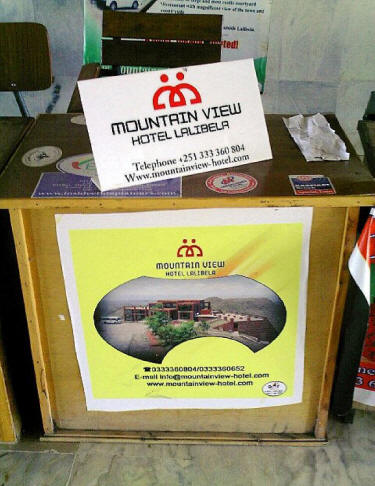
Lalibela Ethiopia: Hotel promotion desks in the
arrival lounge of the airport.
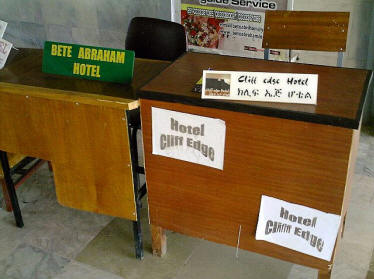
Axum Ethiopia: Hotel Cliff Edge
near the Mountain View promotion desks in the
arrival lounge of the airport.
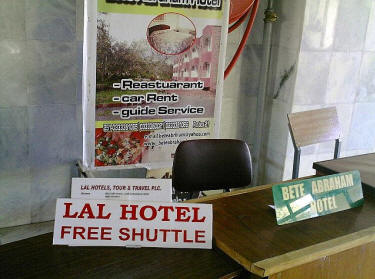
Lalibela Ethiopia: Hotel promotion desks in the
arrival lounge of the airport.
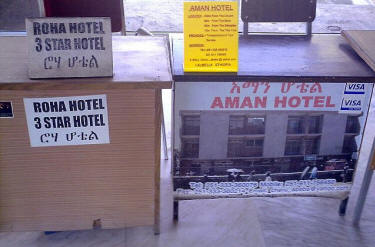
Lalibela Ethiopia: Hotel promotion desks in the
arrival lounge of the airport.
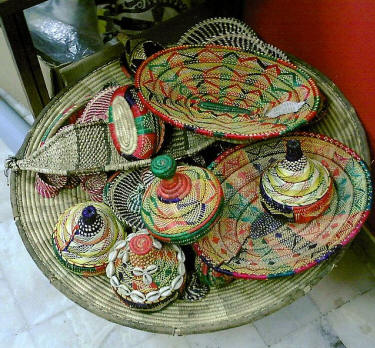
Lalibela Ethiopia: Curios on display in the
departure lounge of the airport.
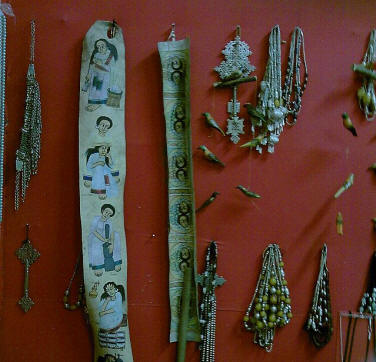
Lalibela Ethiopia: Curios on display in the
departure lounge of the airport.
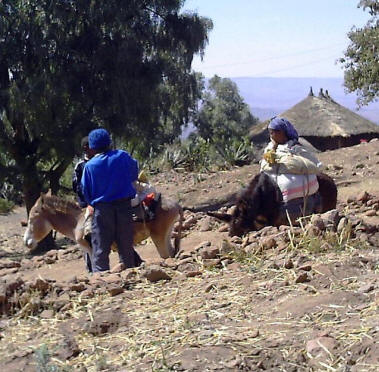
Lalibela Ethiopia: Local people climb steep paths that connect many of the
eleven rock-hewn churches located in this region. Here a couple and their
heavily loaded donkeys reposition the load.
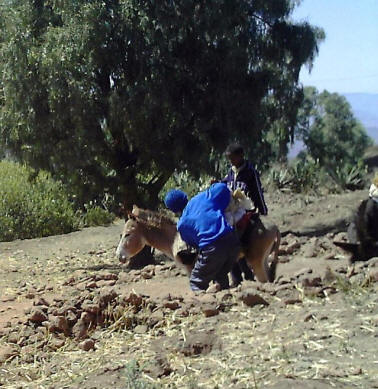
Lalibela Ethiopia: Local people climb steep paths that connect many of the
eleven rock-hewn churches located in this region. Here a couple and their
heavily loaded donkeys reposition the load.

Lalibela Ethiopia: Painting hanging in the departure
lounge of the airport.

Lalibela Ethiopia: Painting hanging in the departure
lounge of the airport.
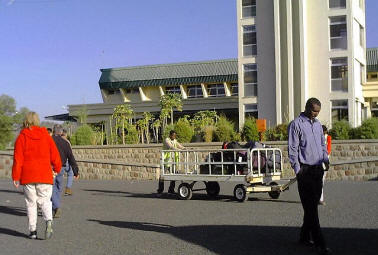
Lalibela Ethiopia: Airport terminal as we land in
Lalibela.

Lalibela Ethiopia: Our plane after we get off in
Lalibela.
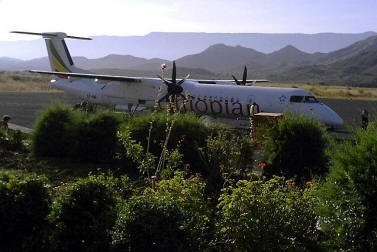
Lalibela Ethiopia: Our
De Havilland Canada / Bombardier Q400 turboprop
plane after we land in Lalibela.
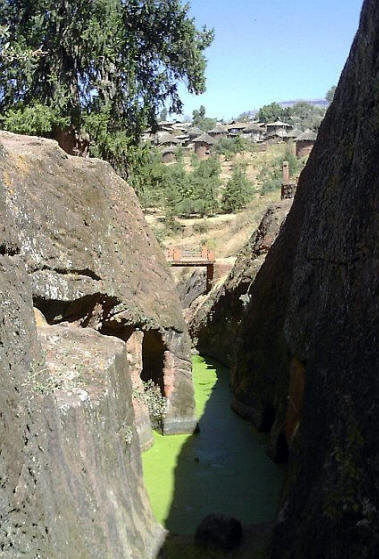
Lalibela Ethiopia: At certain times of the year water floods some of the
numerous tunnels and trenches which connect many of the eleven rock-hewn
churches located in this region.
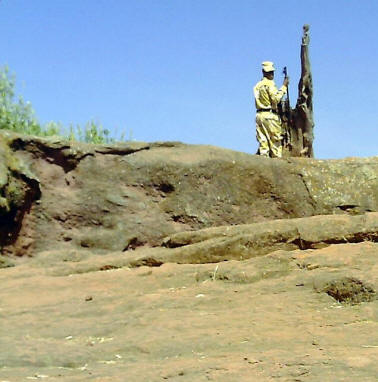
Lalibela Ethiopia: From this high vantage point armed guards keep watch over
the antiquities which are a part of the eleven rock-hewn churches located in
this region.
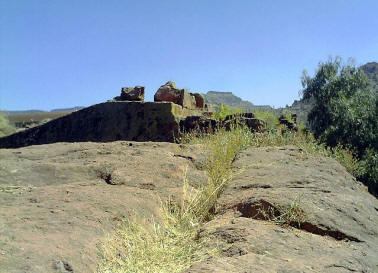
Lalibela Ethiopia: Area around one of the surface entry points into
underground tunnels connecting the eleven rock-hewn churches located in this
region.

Lalibela Ethiopia: At certain times of the year water floods some of the
numerous tunnels and trenches which connect many of the eleven rock-hewn
churches located in this region.

Lalibela Ethiopia: Numerous tunnels and trenches connect many of the eleven
rock-hewn churches located in this region.
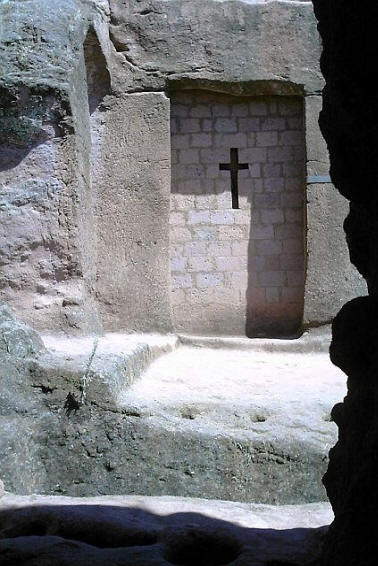
Lalibela Ethiopia: This looks like a blocked up door into one of the
original structures that is a part of the eleven rock-hewn churches located
in this region.
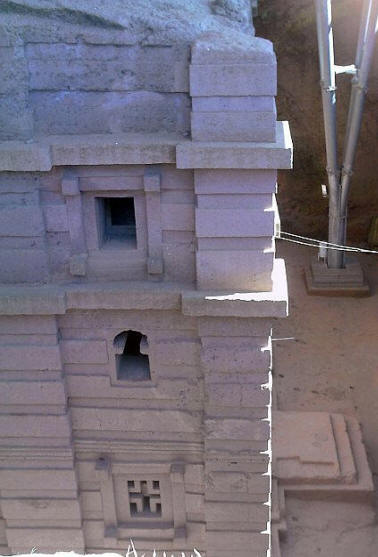
Lalibela Ethiopia: Details of sculptured windows in the wall of one of the
eleven rock-hewn churches located in this region.
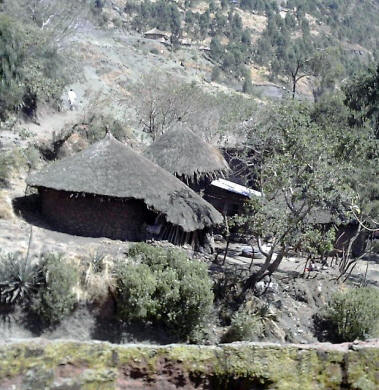
Lalibela Ethiopia: One of the villages located immediately adjacent to one
of the eleven rock-hewn churches located in this region.
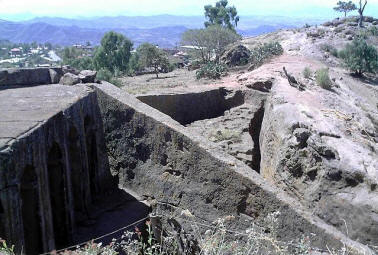
Lalibela Ethiopia: Looking down into the trench surrounding one of the
eleven rock-hewn churches located in this region.
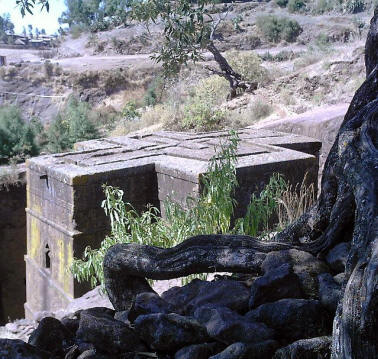
Lalibela Ethiopia: Another view of the Biet Giyougis or Church of St.
George, the most famous of the eleven rock-hewn churches located in this
region. I took a lot of photos as I circumambulated this iconic structure as
I'll never be here again.
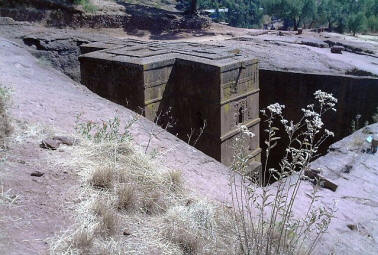
Lalibela Ethiopia: First view seen by visitors of the Biet Giyougis or
Church of St. George, the most famous of the eleven rock-hewn churches
located in this region.

Lalibela Ethiopia: Looking down into the trench surrounding the Biet
Giyougis or Church of St. George, the most famous of the eleven rock-hewn
churches located in this region.
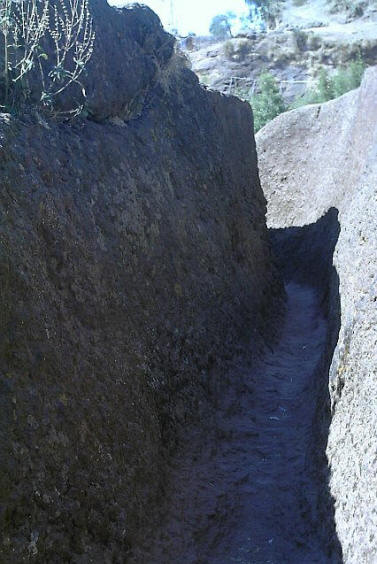
Lalibela Ethiopia: View of the trench leading to the entrance of the Biet
Giyougis or Church of St. George, the most famous of the eleven rock-hewn
churches located in this region.
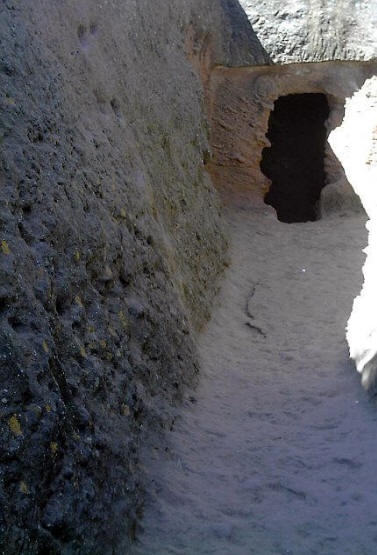
Lalibela Ethiopia: View of the trench and tunnel leading to the entrance of
the Biet Giyougis or Church of St. George, the most famous of the eleven
rock-hewn churches located in this region.
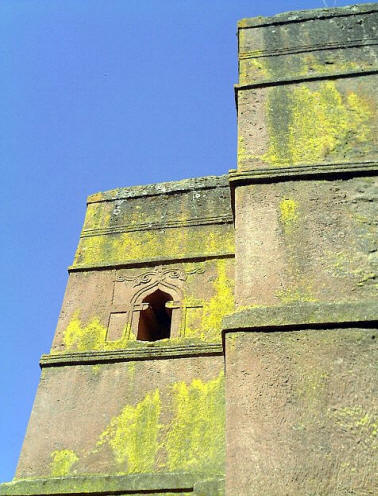
Lalibela Ethiopia: Closeup view of walls of the Biet Giyougis or Church of
St. George, the most famous of the eleven rock-hewn churches located in this
region.

Lalibela Ethiopia: Trash can sitting in the trench surrounding the Biet
Giyougis or Church of St. George, the most famous of the eleven rock-hewn
churches located in this region.
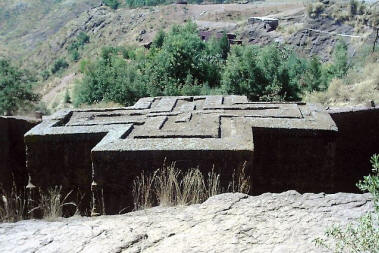
Lalibela Ethiopia: Another view from an other
angle of the Biet Giyougis or Church of St. George, the most famous of the
eleven rock-hewn churches located in this region. I took a lot of photos as
I circumambulated this iconic structure as I'll never be here again.
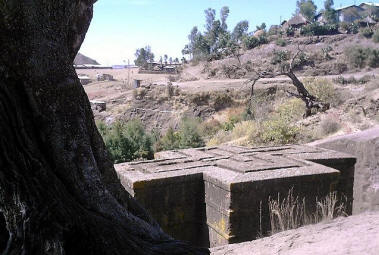
Lalibela Ethiopia: Another view of the Biet Giyougis or Church of St.
George, the most famous of the eleven rock-hewn churches located in this
region. I took a lot of photos as I circumambulated this iconic structure as
I'll never be here again.
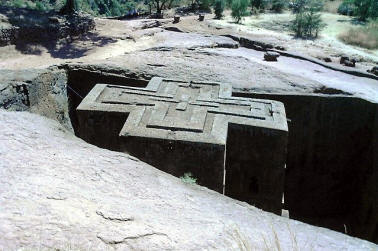
Lalibela Ethiopia: Another view of the Biet Giyougis or Church of St.
George, the most famous of the eleven rock-hewn churches located in this
region. I took a lot of photos as I circumambulated this iconic structure as
I'll never be here again.
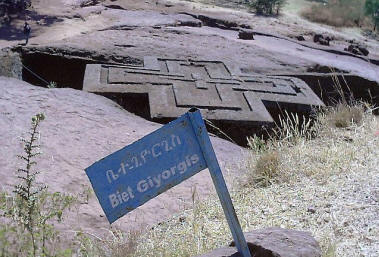
Lalibela Ethiopia: First view seen by visitors of the Biet Giyougis or
Church of St. George, the most famous of the eleven rock-hewn churches
located in this region.
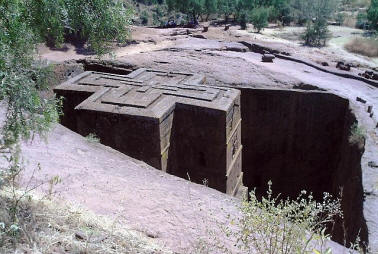
Lalibela Ethiopia: First view seen by visitors of the Biet Giyougis or
Church of St. George, the most famous of the eleven rock-hewn churches
located in this region.
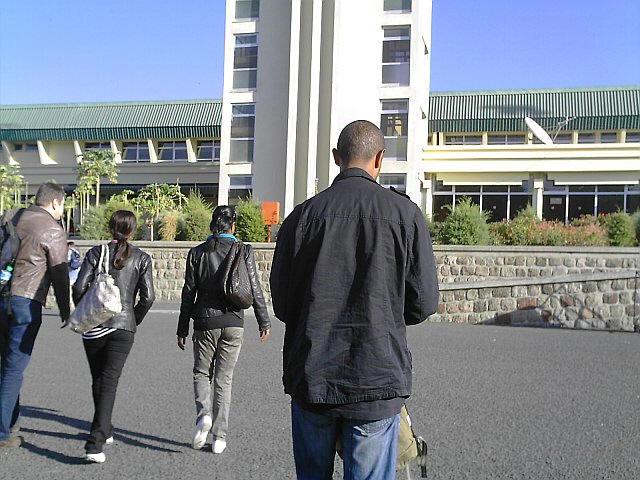
Lalibela Ethiopia: Airport terminal as we land in Lalibela. |


